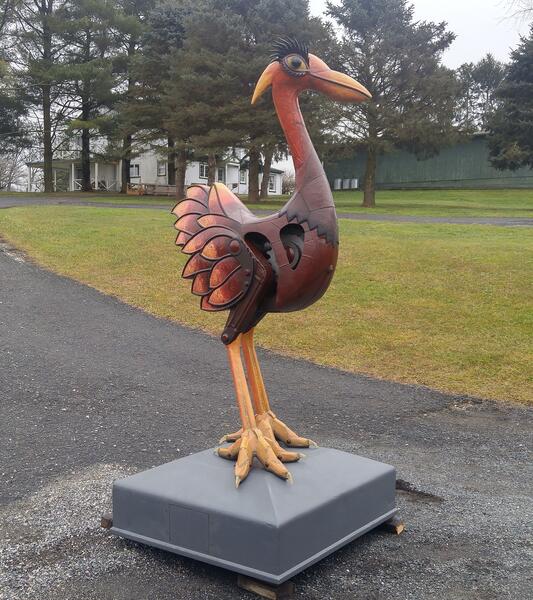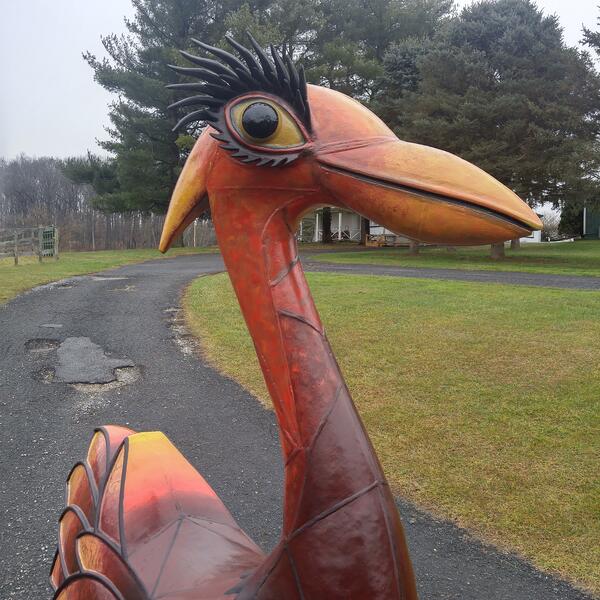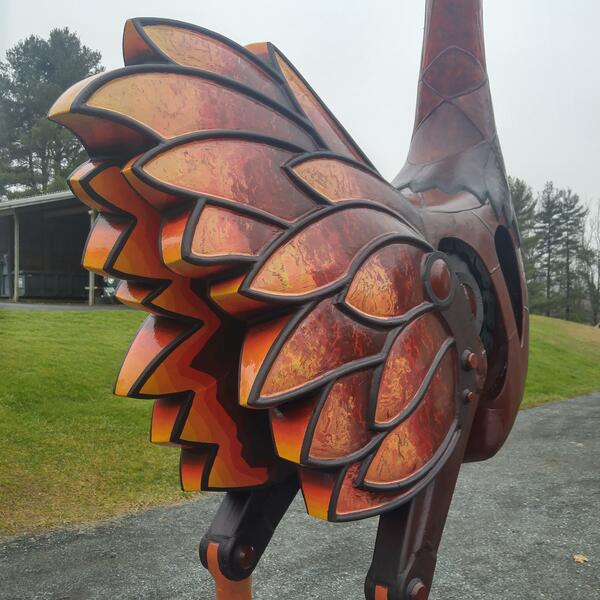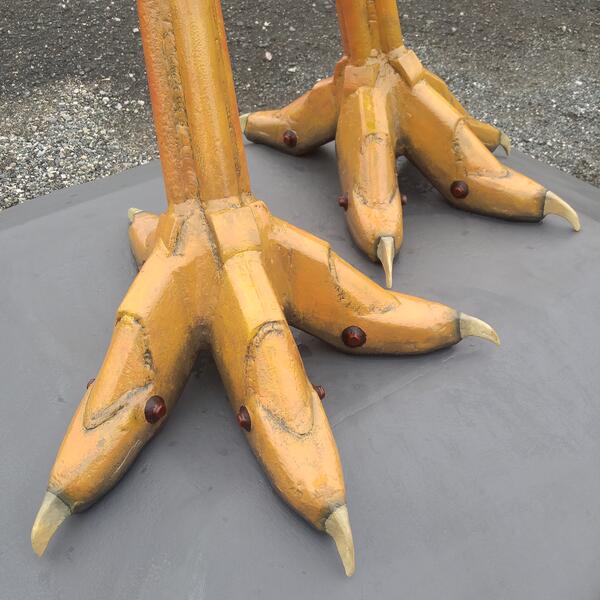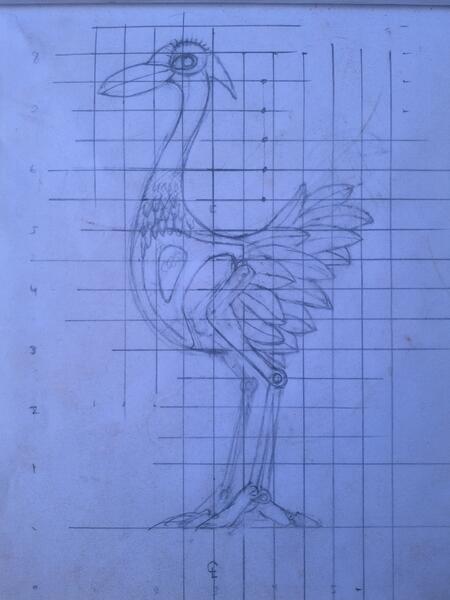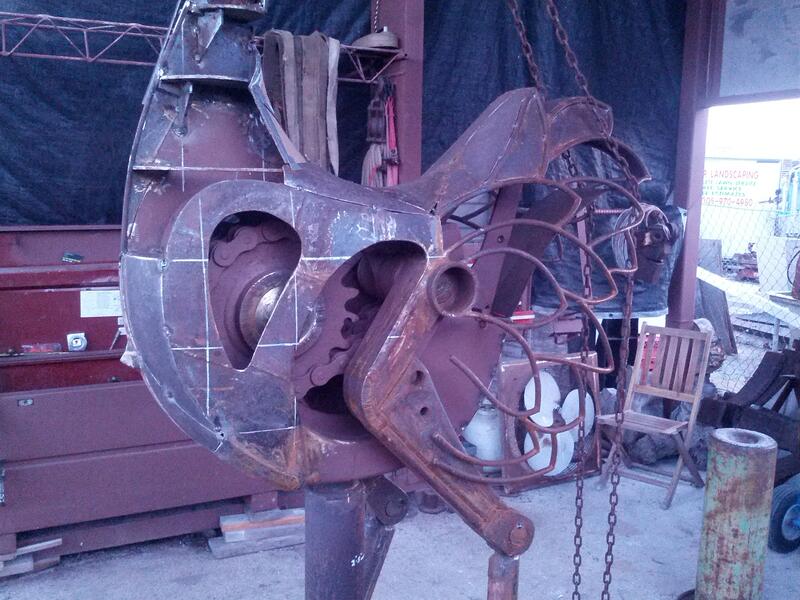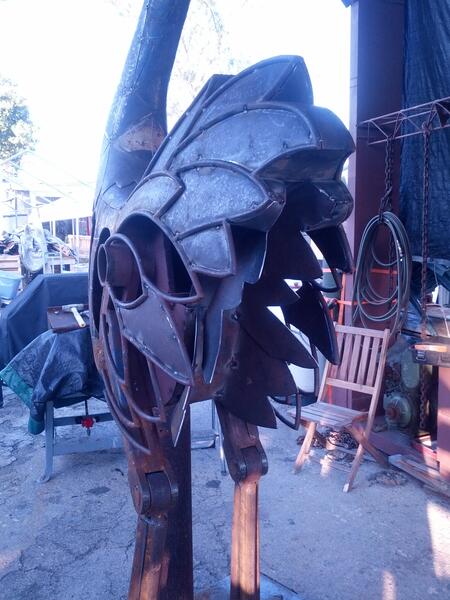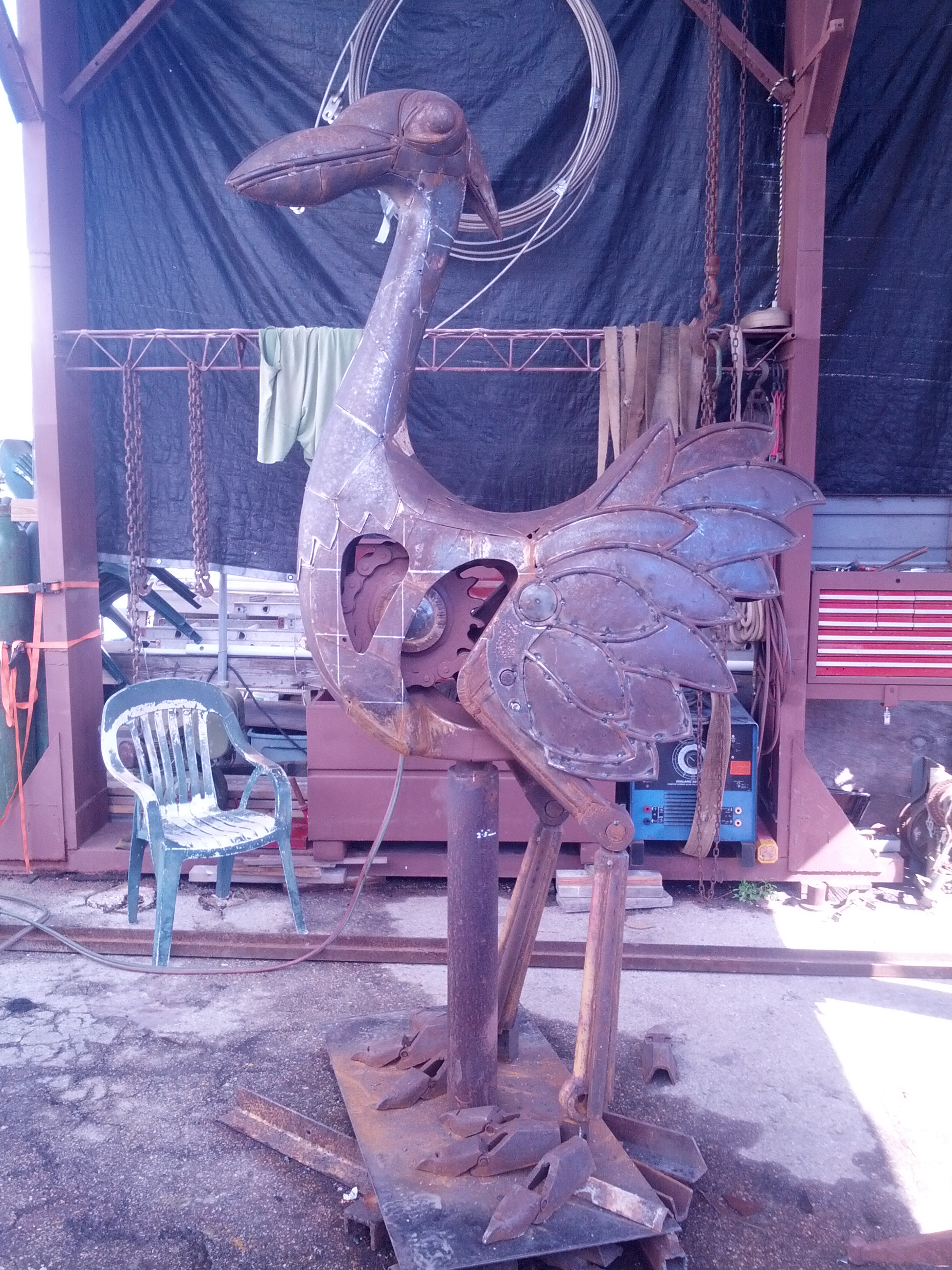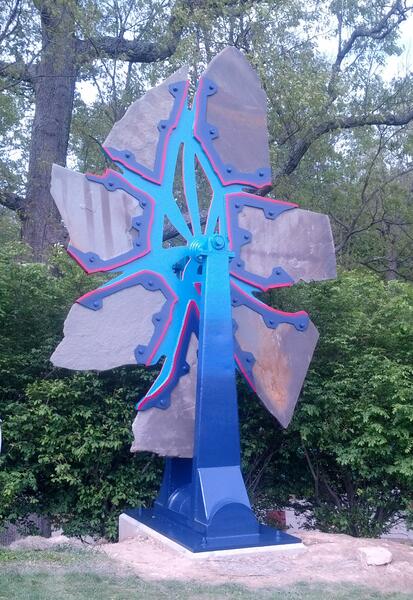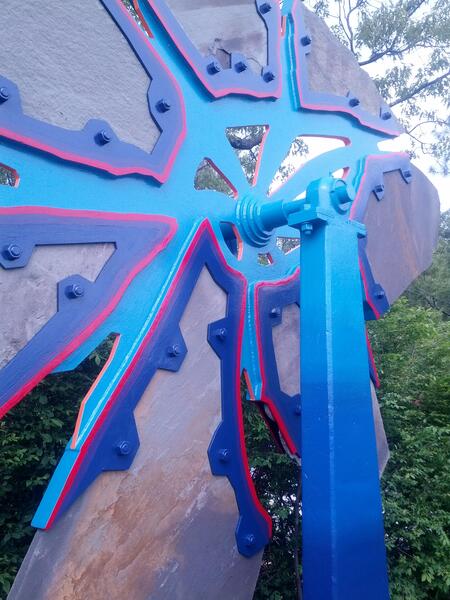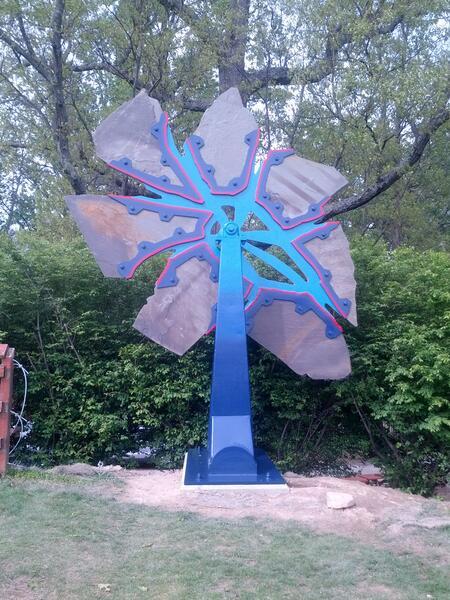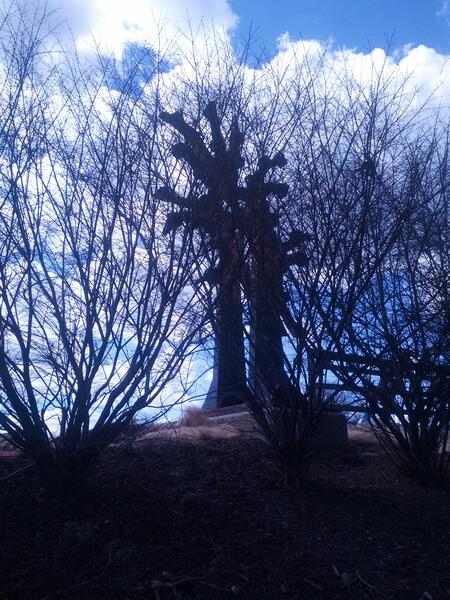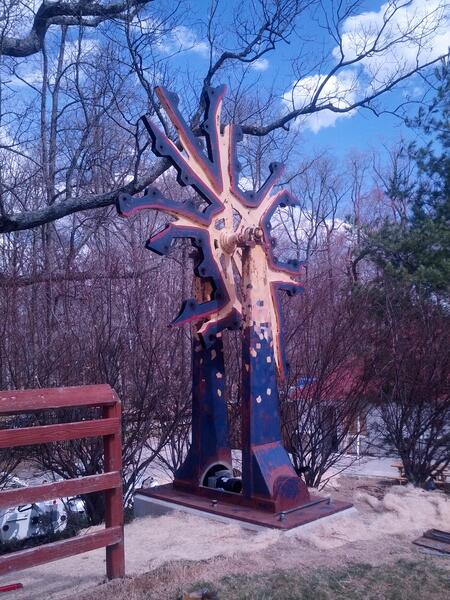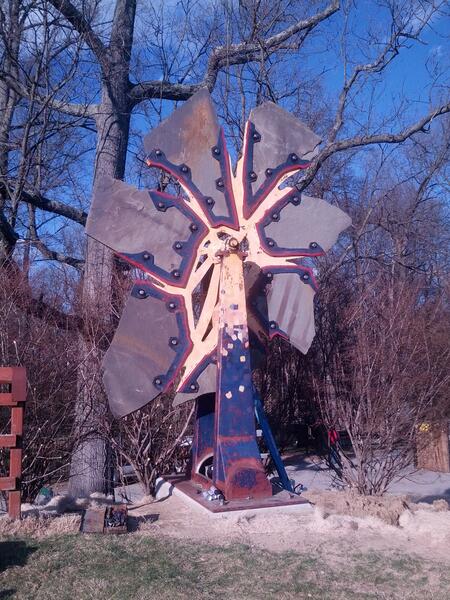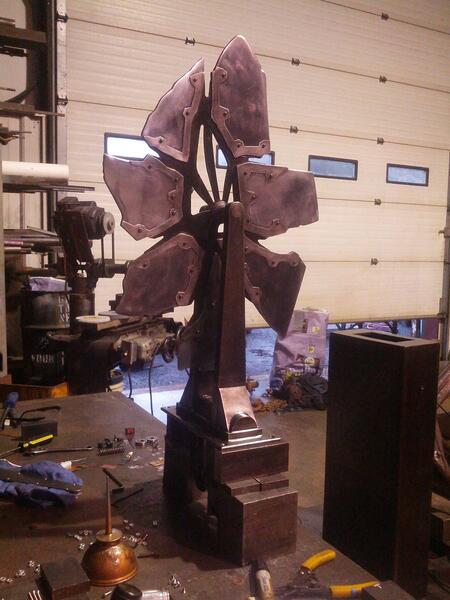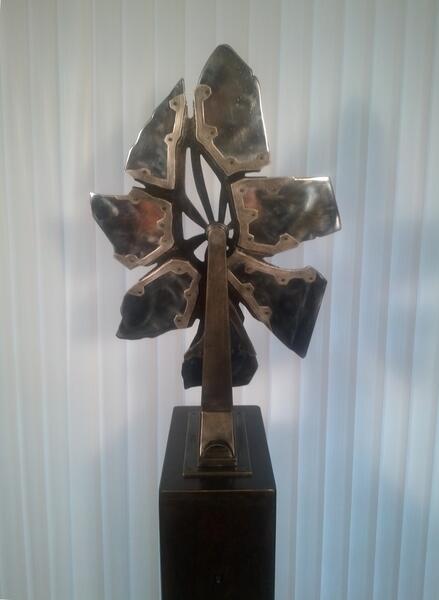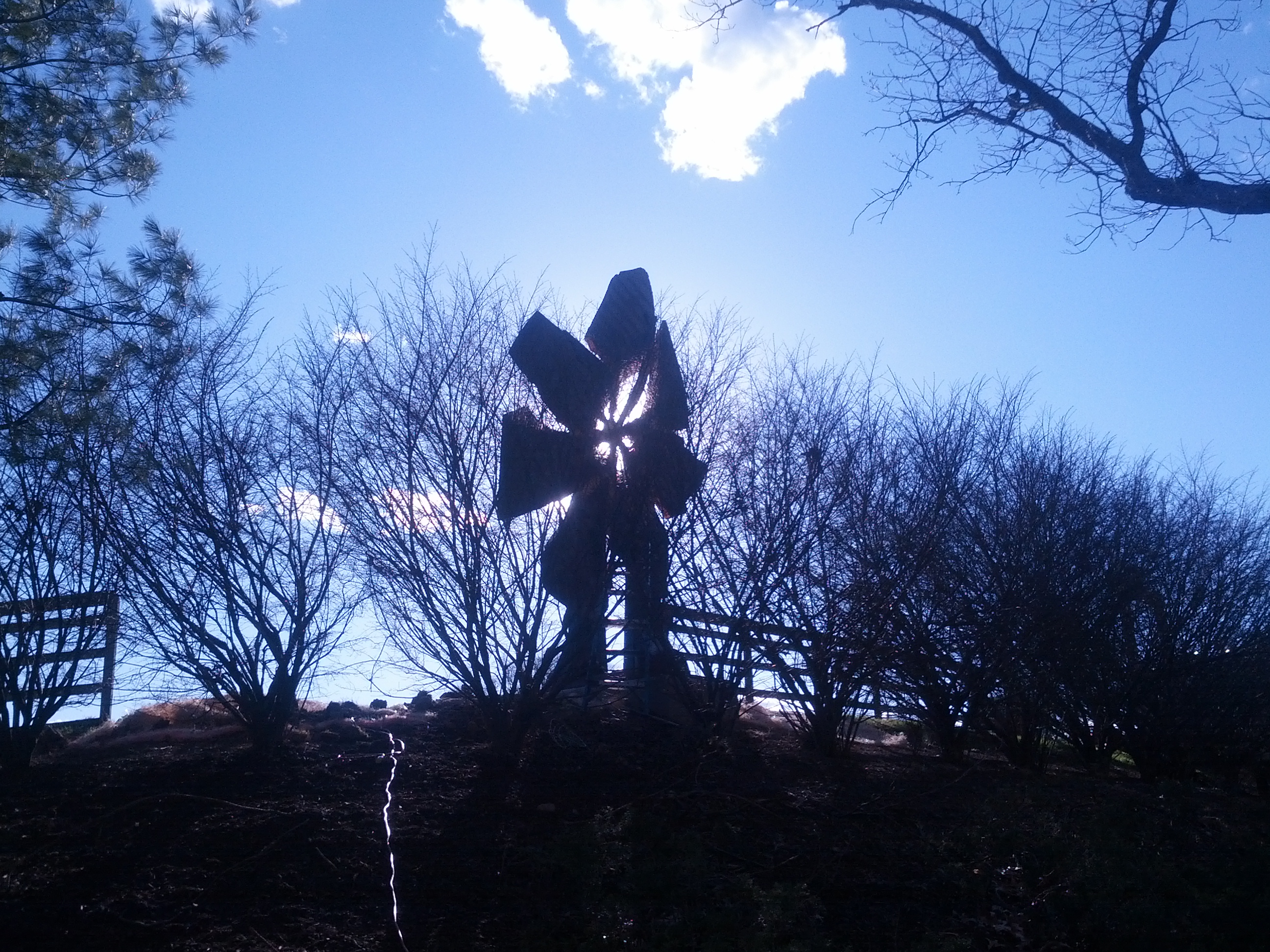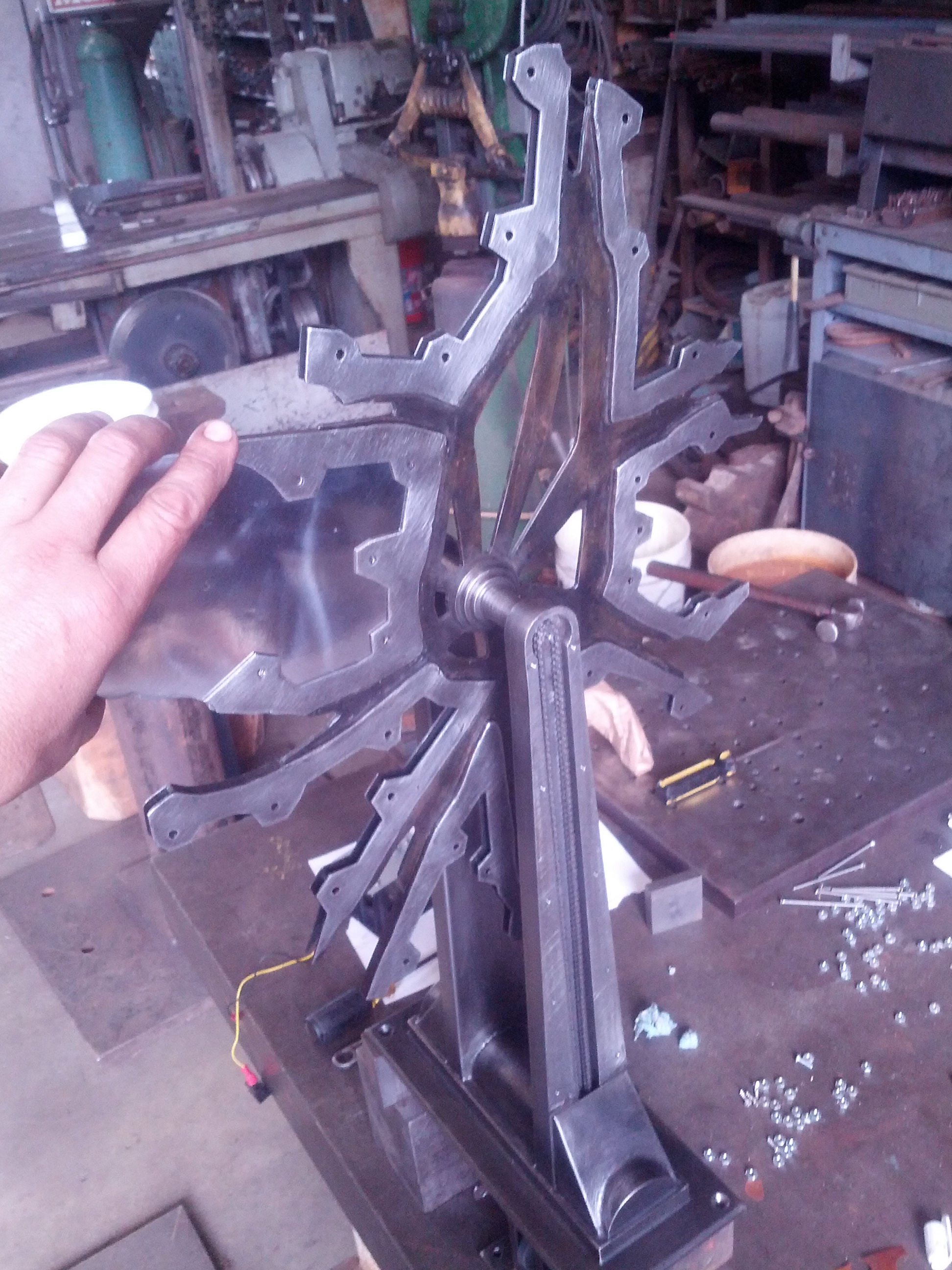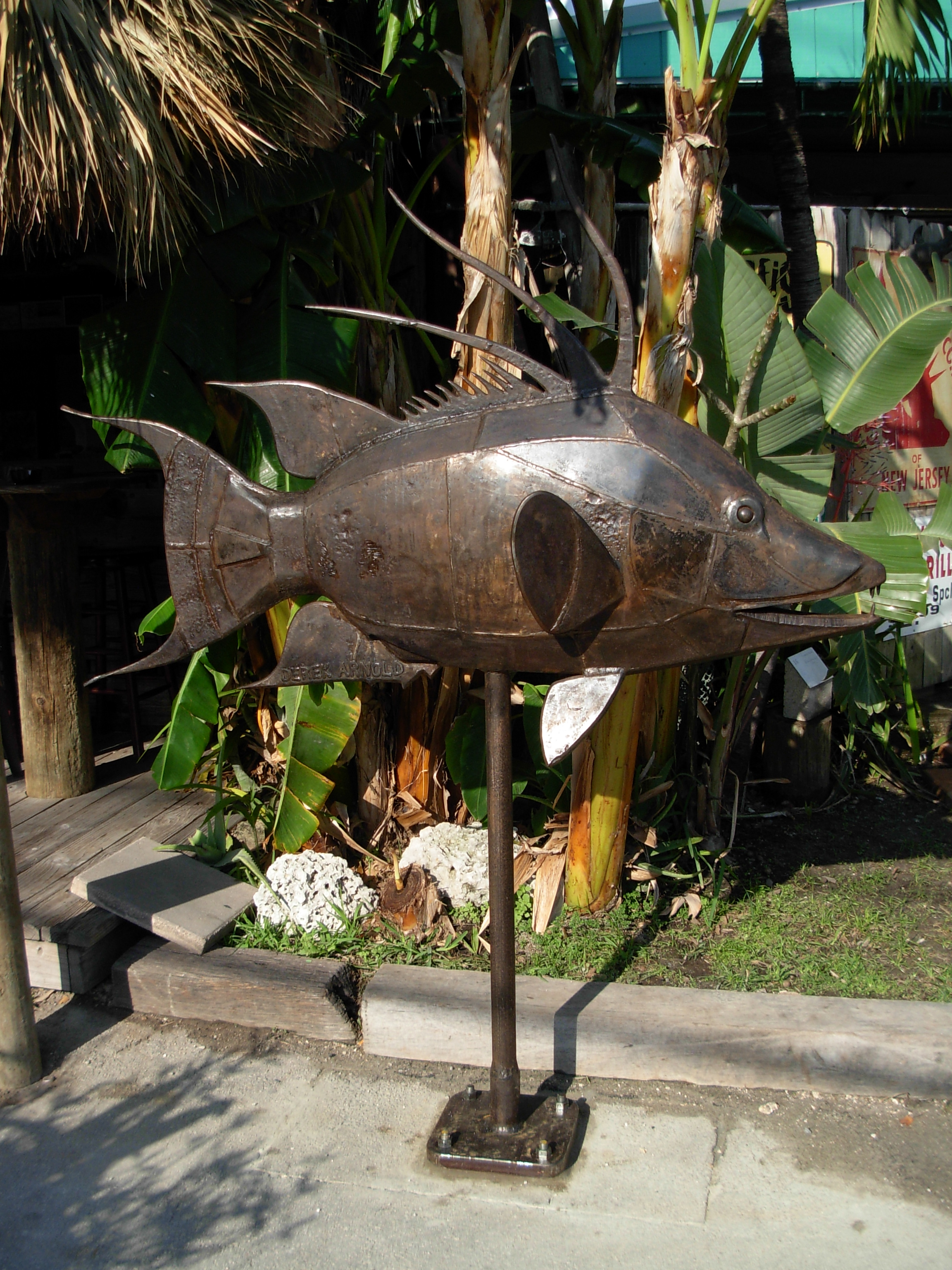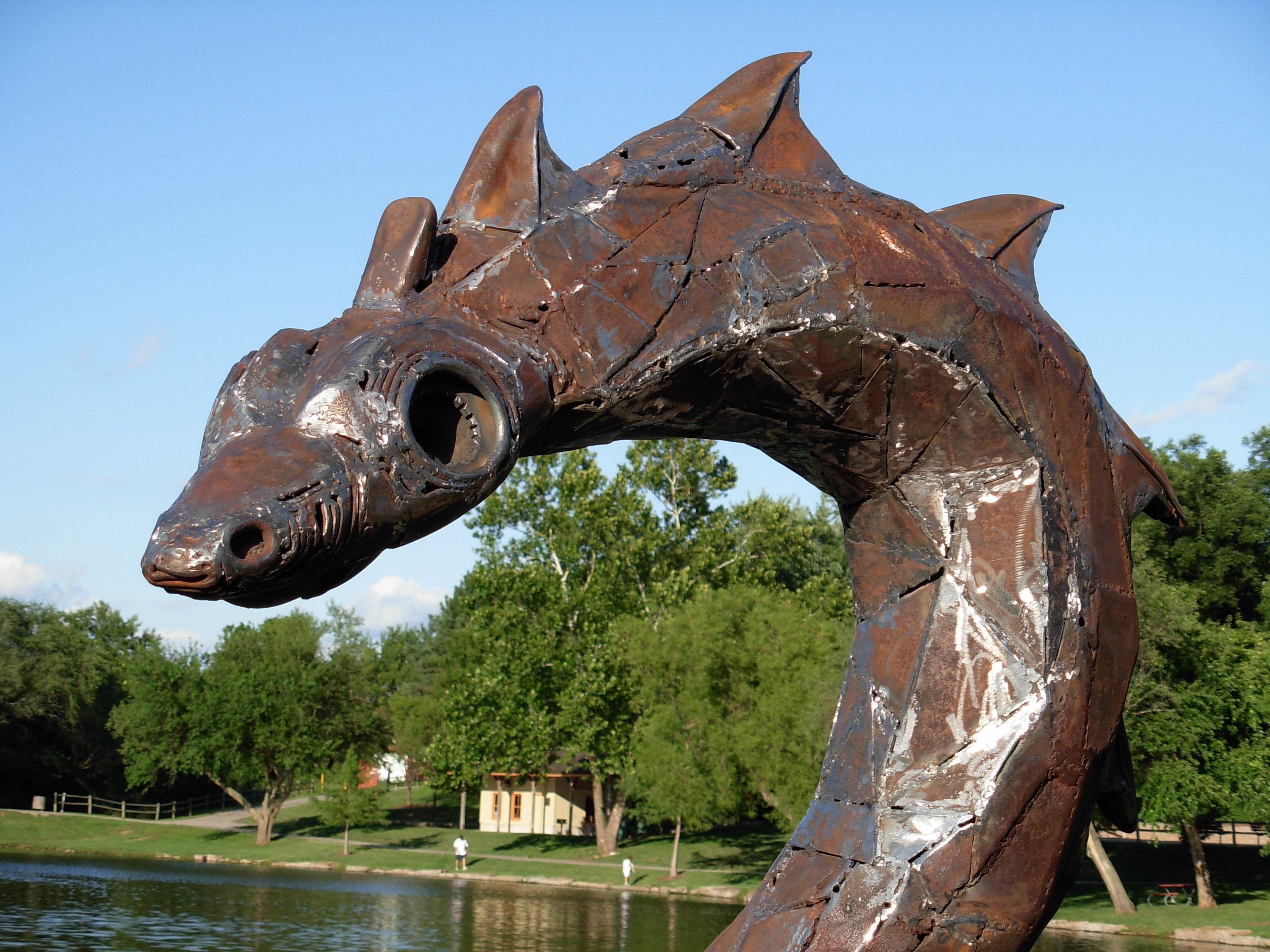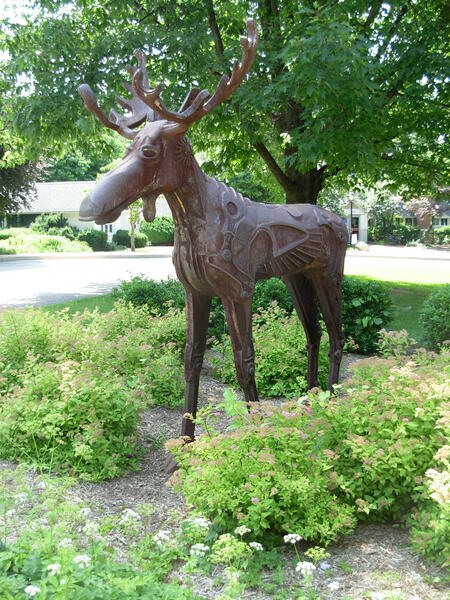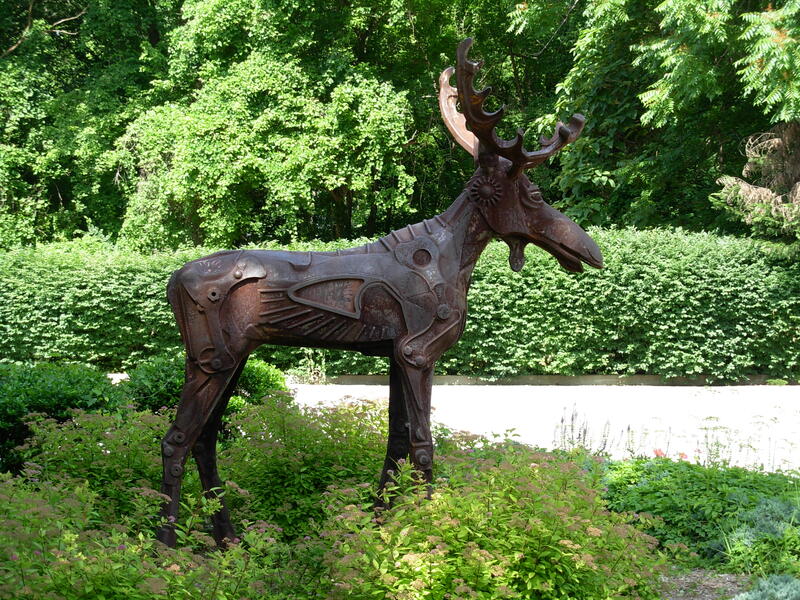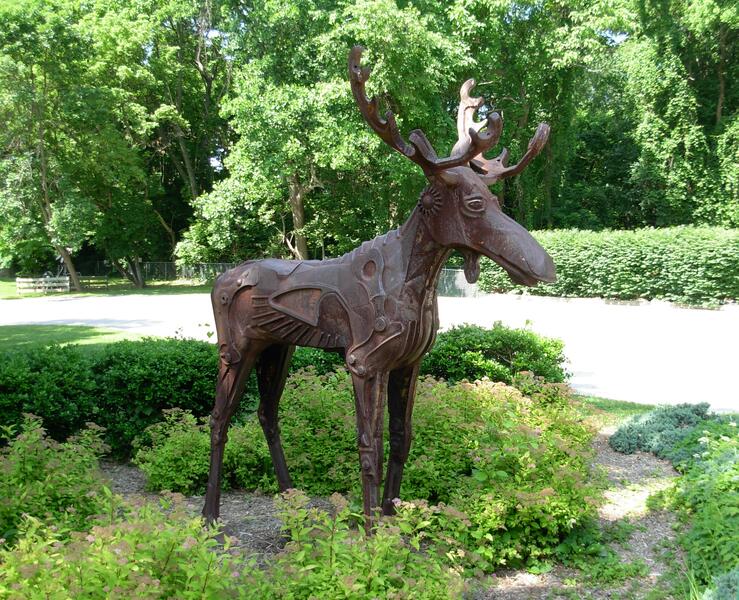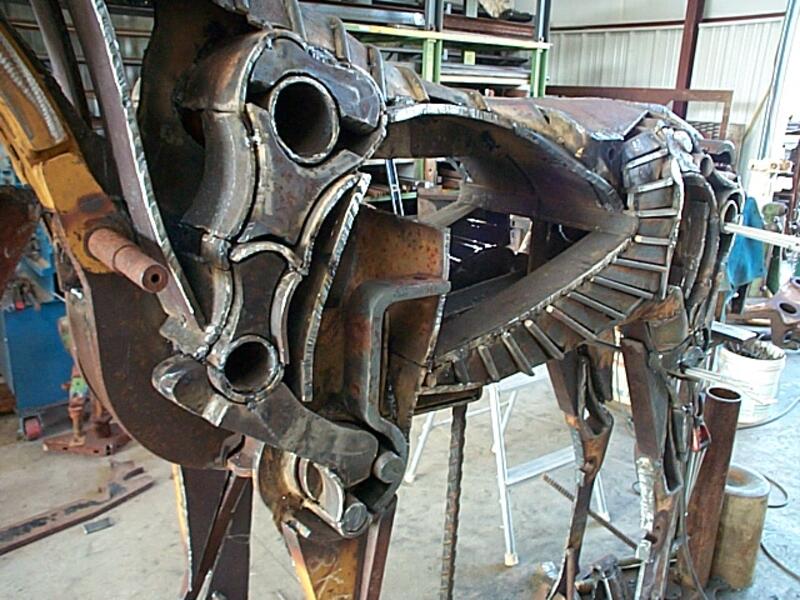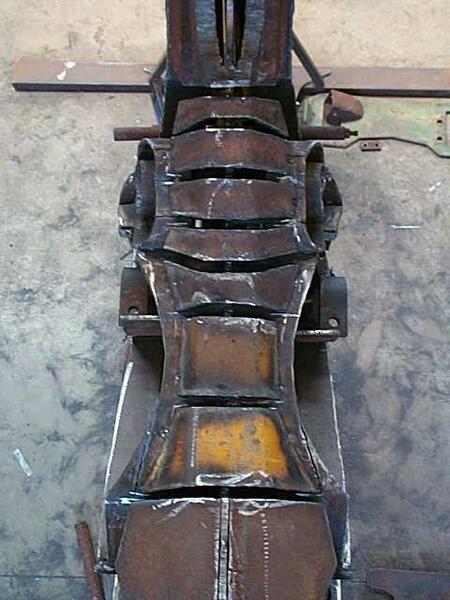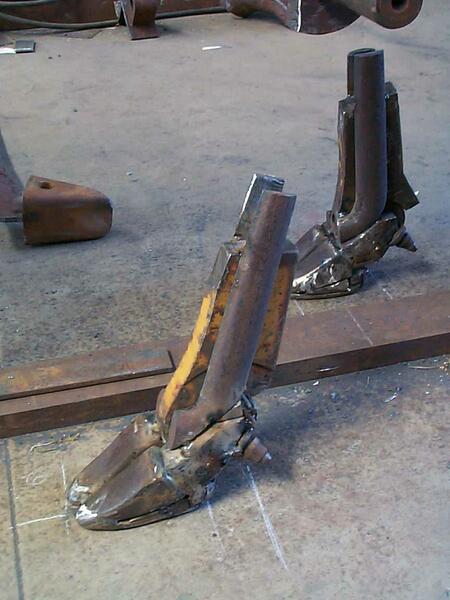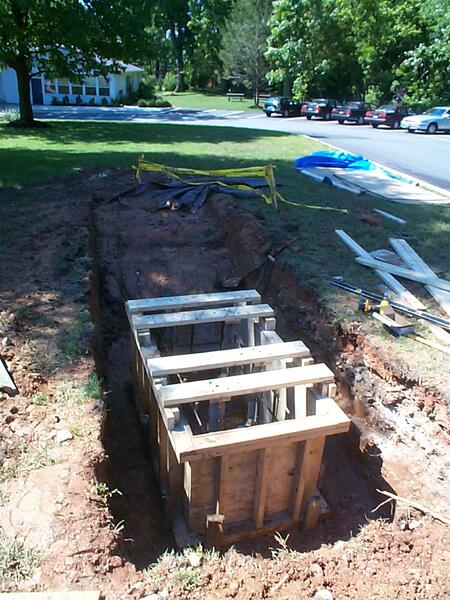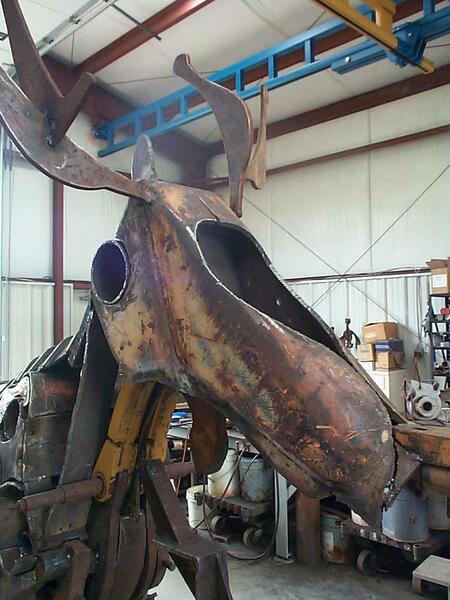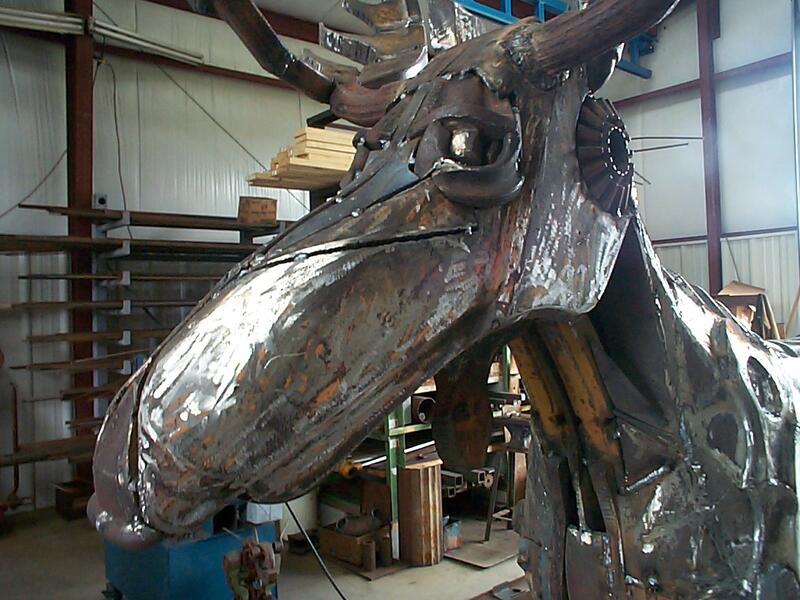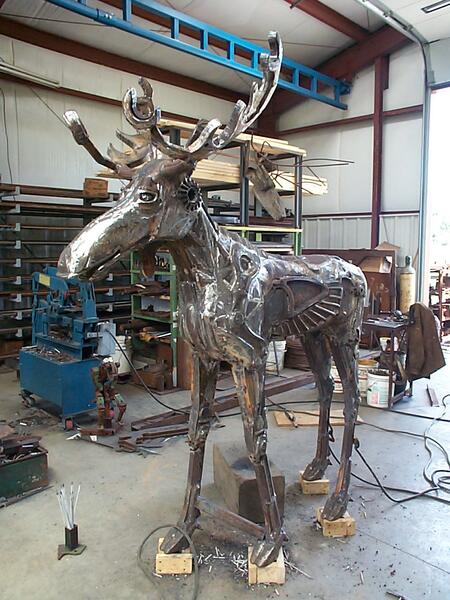Work samples
About Derek
Since graduating from Maryland Institute College of Art in 1993, Derek Arnold has completed numerous projects large and small. His work shows a true dedication to art and his craft. He has maintained his studio in Harford county Maryland for nearly thirty years.
Derek works primarily using steel that has a unique history and character. He is drawn to old construction equipments that display elements of engineering and industrial processes. Flame cutting, welding, and machining are… more
Derek works primarily using steel that has a unique history and character. He is drawn to old construction equipments that display elements of engineering and industrial processes. Flame cutting, welding, and machining are… more
Jump to a project:
A.S.H.I.M.E.S.
Architectural, Structural, Horticultural, Industrial, Mechanical, Engineered Sculpture.
This piece started with a six hundred pound train wheel and a very large impeller. It evolved over a two year period. It weighs about 3500 lbs and is held by a concrete foundation of 22,000 lbs. The Lily rotates and the entire structure also rotates around the center, swinging a 30 foot diameter. It is simply pushed to change the location in the garden.
This piece started with a six hundred pound train wheel and a very large impeller. It evolved over a two year period. It weighs about 3500 lbs and is held by a concrete foundation of 22,000 lbs. The Lily rotates and the entire structure also rotates around the center, swinging a 30 foot diameter. It is simply pushed to change the location in the garden.
Giant Key West Chicken
I was visiting Key West and found an old landfill compactor and a trenching machine. I found out who owned them and acquired them for sculpting materials. I sent in a proposal for Sculpture Key West and was accepted. I sold my car to pay for consumables and the tireless help of a few buddies, and we constructed the rooster in six weeks. When we arrived, first, we had to build a bridge crane to lift the chicken parts. I made a deal with the local scrap metal guy and got some old crane parts that came from a navy building. Then we began the two weeks time of disassembling the old machines. Someone saw what we were doing and donated a road grader. Four more weeks of steady work on the giant rooster and it was as complete as it was going to be, there was a deadline for the opening reception, and we made it! The Giant Key West Chicken was a big success and won the Grande Esplanade Award!!
This piece was hard work and took nine hundred hours to complete. It is fitted with a dashboard and seat, hydraulic controls and cylinders. The entire body moves left and right and the beak opens and closes!
This big bird has lived in Key West, Florida for two years, Baltimore, Maryland for three years, Martha's Vineyard, Massachusetts for the last ten years and will soon be moving to Austin, Texas.
This piece was hard work and took nine hundred hours to complete. It is fitted with a dashboard and seat, hydraulic controls and cylinders. The entire body moves left and right and the beak opens and closes!
This big bird has lived in Key West, Florida for two years, Baltimore, Maryland for three years, Martha's Vineyard, Massachusetts for the last ten years and will soon be moving to Austin, Texas.
-
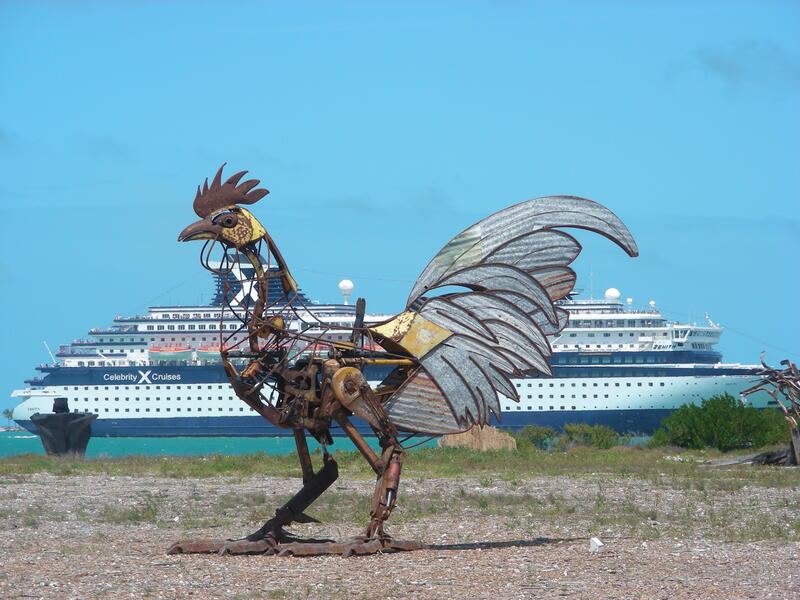 Giant Key West Rooster15 feet tall. 7500lbs. Steel from a landfill compactor, a trenching machine, a road grader, and some tin roof.
Giant Key West Rooster15 feet tall. 7500lbs. Steel from a landfill compactor, a trenching machine, a road grader, and some tin roof. -
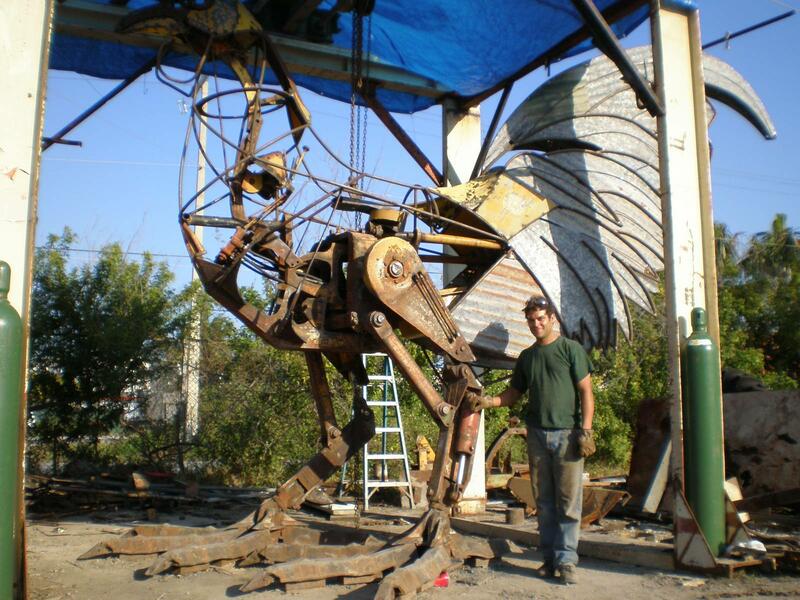 One BIG chicken!Standing 15 feet high the completion is near.
One BIG chicken!Standing 15 feet high the completion is near. -
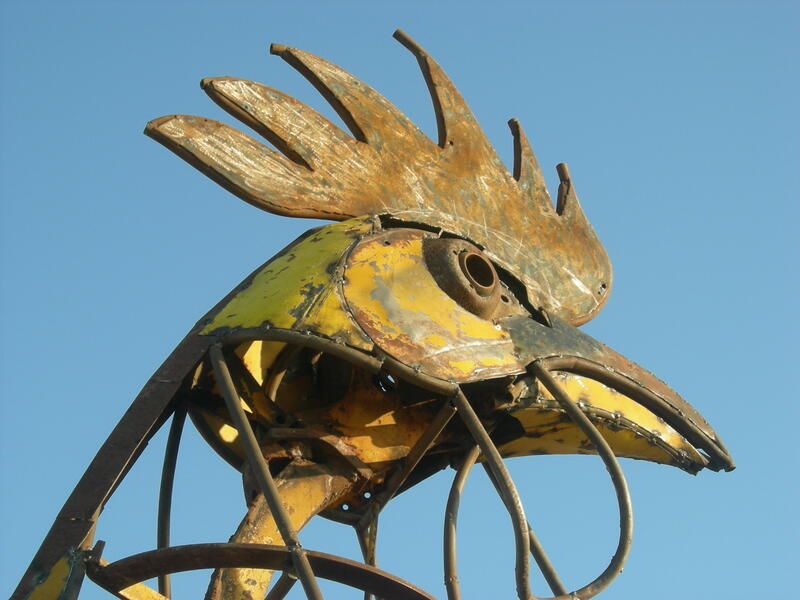 The Rooster's HeadThe beak opens and closes from a control lever in the driver's cockpit!
The Rooster's HeadThe beak opens and closes from a control lever in the driver's cockpit! -
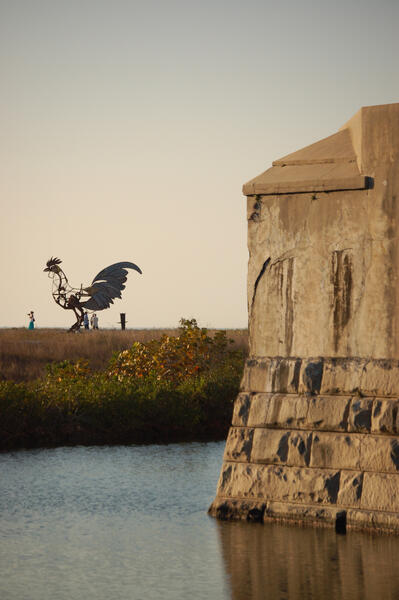 Giant Key West ChickenSighted from across the Ft. Zachary Taylor mote.
Giant Key West ChickenSighted from across the Ft. Zachary Taylor mote. -
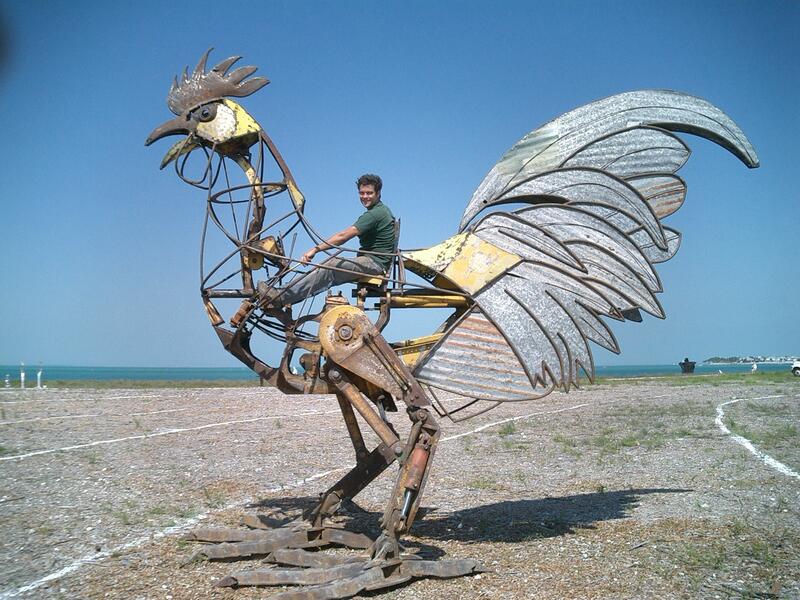 The rooster crows!Assembled at Ft. Zachary Taylor just in time.
The rooster crows!Assembled at Ft. Zachary Taylor just in time. -
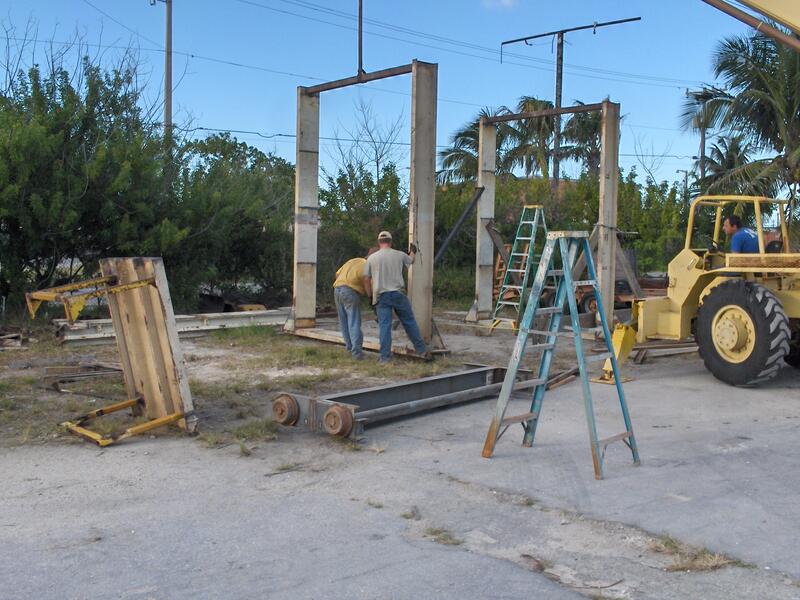 Building the bridge craneThese parts were originally a crane that was removed from a Navy building on Stock Island. I modified the pieces to fit a chicken.
Building the bridge craneThese parts were originally a crane that was removed from a Navy building on Stock Island. I modified the pieces to fit a chicken. -
 Landfill compactor.In process of disassembly.
Landfill compactor.In process of disassembly. -
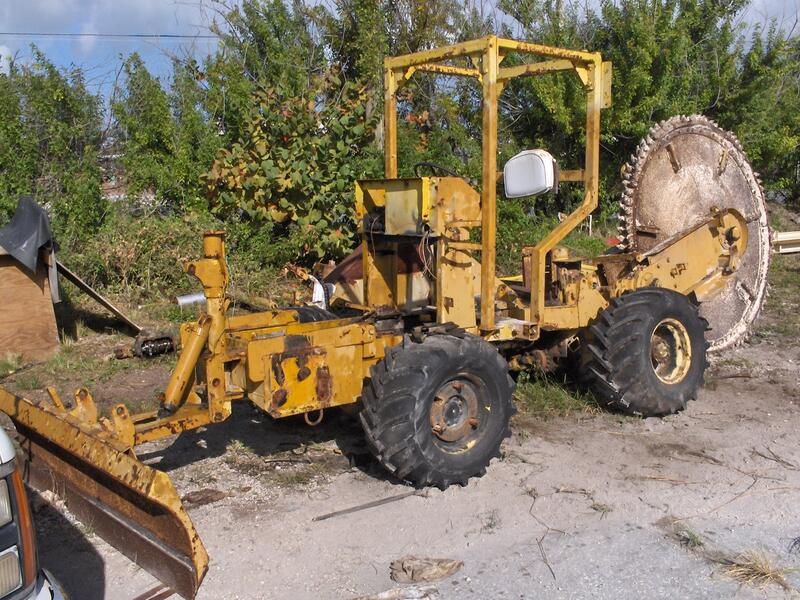 Trenching machine.Originally owned by the Key West Aquaduct Authority, this machine provided many parts for the sculpture.
Trenching machine.Originally owned by the Key West Aquaduct Authority, this machine provided many parts for the sculpture. -
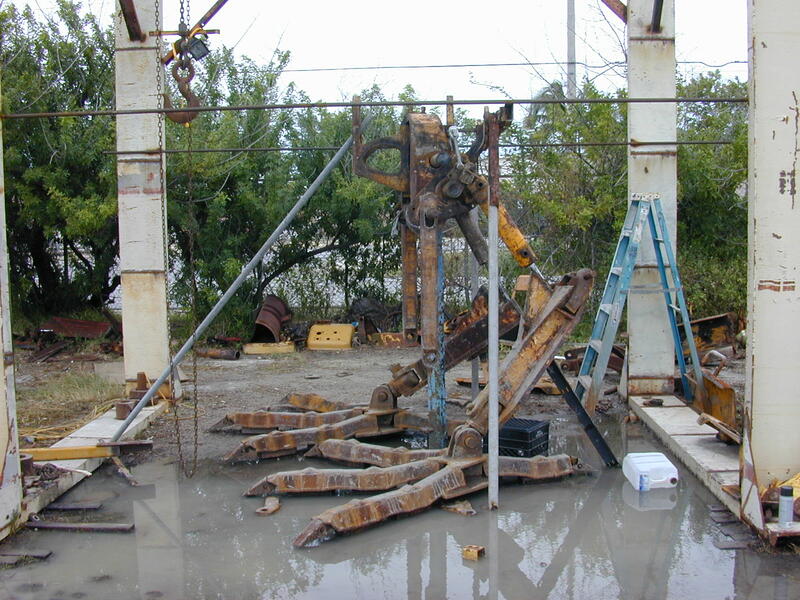 Hips, Legs and FeetA rainy morning left a huge puddle at the chicken's feet. Here you can see that the feet are made from the large landfill compactor wheels.
Hips, Legs and FeetA rainy morning left a huge puddle at the chicken's feet. Here you can see that the feet are made from the large landfill compactor wheels. -
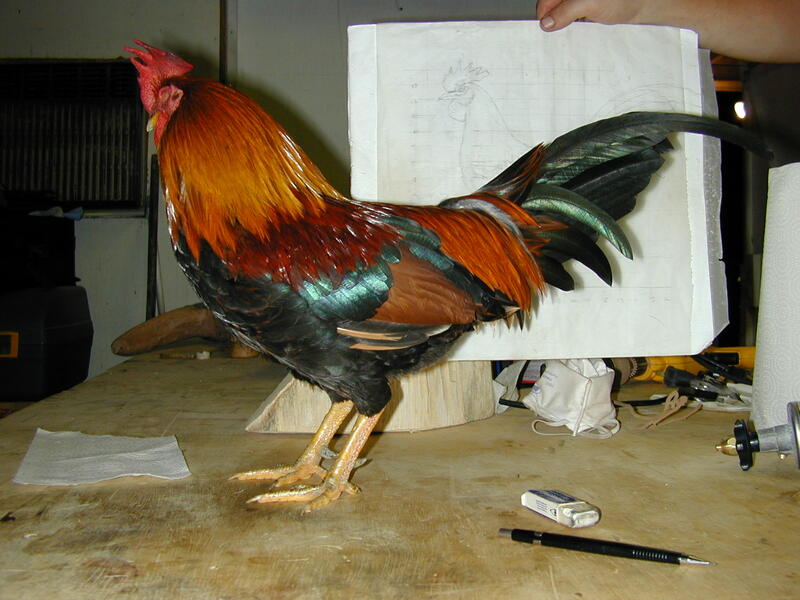 The model."Spirit', the one eyed rooster from Key West.
The model."Spirit', the one eyed rooster from Key West.
Lucybird
Lucybird is made with steel plates, sheets and a few modified machine parts. It's ten feet in height, and weighs about one ton.
Stones and Steel
Seven precisely balanced stones are held together by steel and rotate around a central axis. The rotation weight of the twelve foot diameter stone and steel wheel weigh in at 3000 pounds. I began designing this piece thinking of a visual layout of the stones. I precisely measured each stone and its center of gravity. Using CAD, I entered the dimensional and weight data into a spreadsheet so I could modify the design easily to achieve precise balance. A CNC torch machine was used to cut the steel plates that hold the stones in place. Motion is driven by a motor, gear reduction, and rheostat to achieve a range of speeds. Modified Caterpillar tractor parts are used as support columns to hold the axis of the work. The piece is fifteen feet high and is bolted to 8 tons of concrete.
Periodical Spaceship Cicada
This project was made during the emergence of the 17 year Periodical Cicada in 2004. There was no shortage of models for this project and I had one very willing who hung around for about a week while I studied its movement. This cicada has five hinges in each leg to achieve a range of motion similar to the insect's real anatomical range-of-motion. One difference that I made was to construct a mouth that looks more like a sharks mouth, instead of the long proboscis.
-
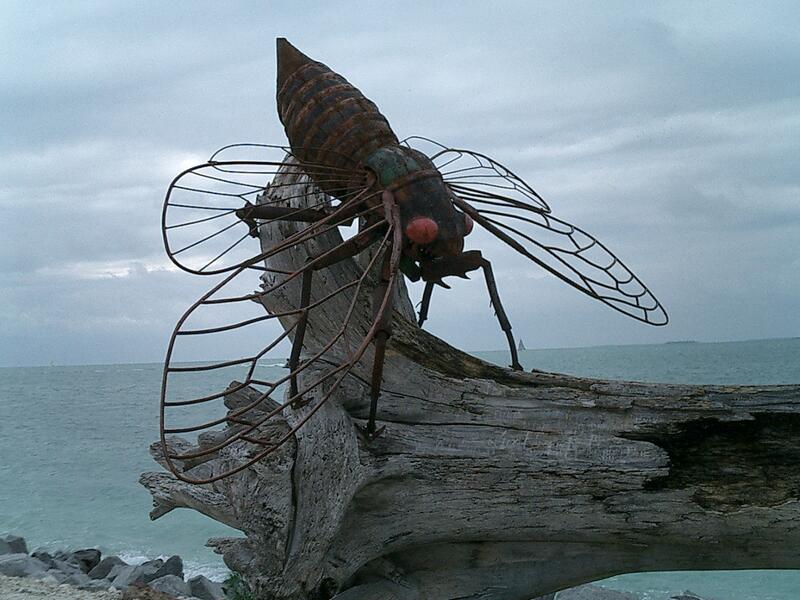 Cicada bolted on a washed up tree13 feet across the wings
Cicada bolted on a washed up tree13 feet across the wings -
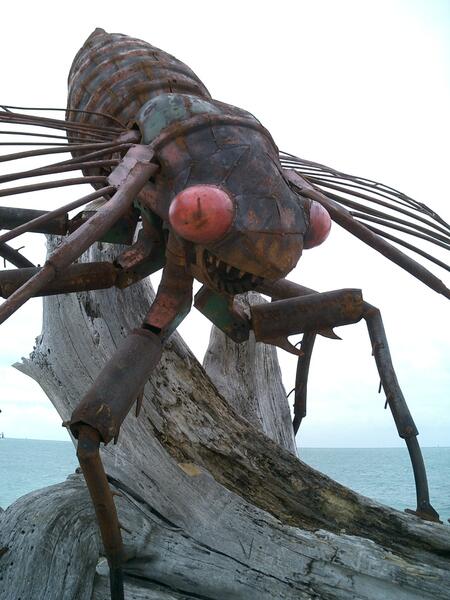 Cidada detail
Cidada detail -
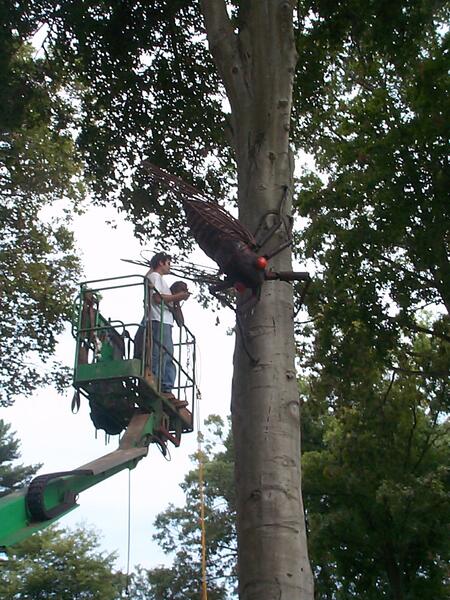 Installing 30 feet up a tree
Installing 30 feet up a tree -
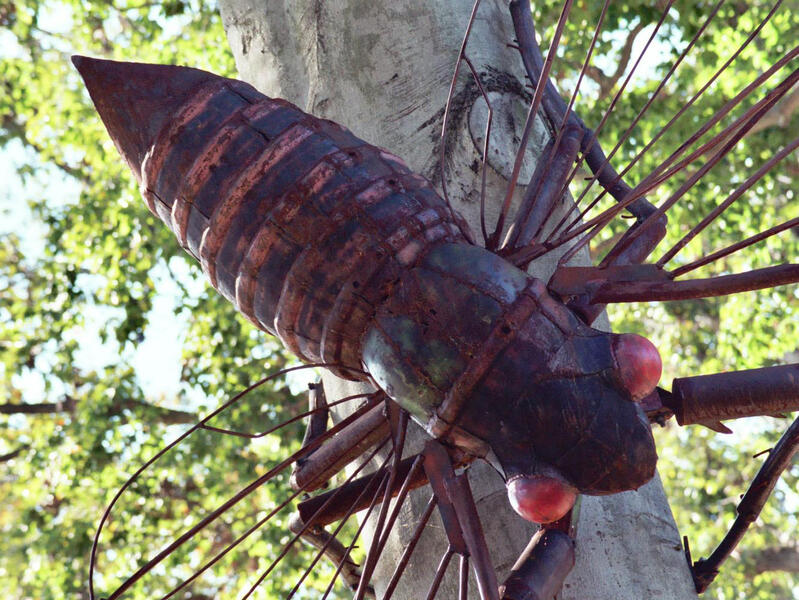 Cicada up closeCicada bolted onto a tree thirty feet up.
Cicada up closeCicada bolted onto a tree thirty feet up. -
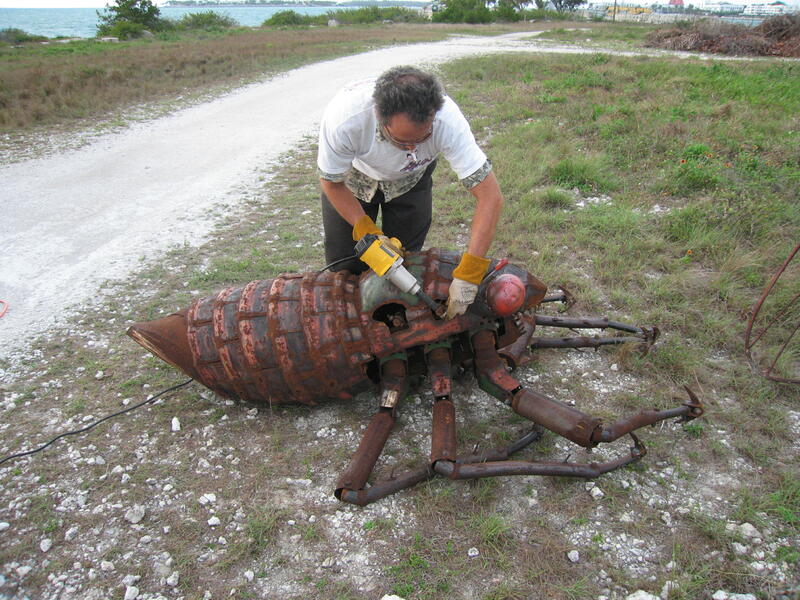 Preparing to install
Preparing to install -
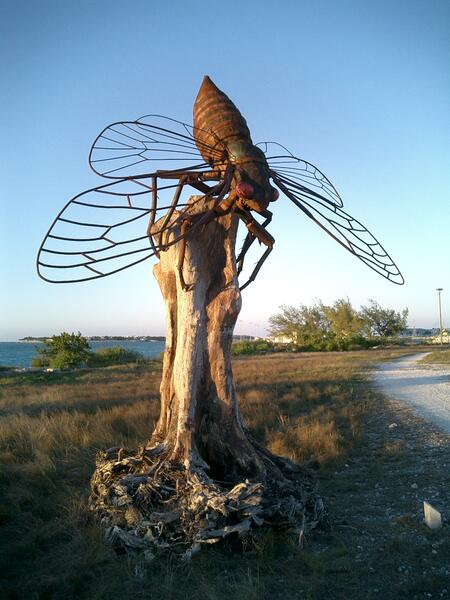 Cicada on an Australian Pine stumpThe stump weighed 6500 lbs. and the cicada weighs 350 lbs.
Cicada on an Australian Pine stumpThe stump weighed 6500 lbs. and the cicada weighs 350 lbs. -
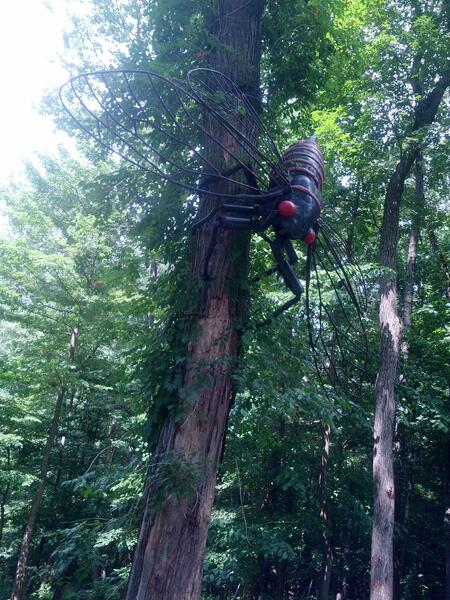 Over head
Over head -
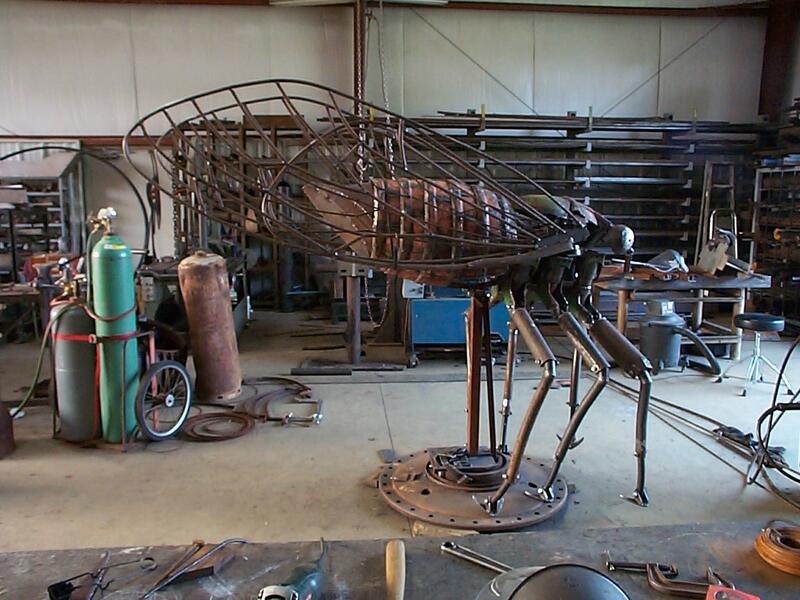 Six foot long wingsMade of steel pipe
Six foot long wingsMade of steel pipe -
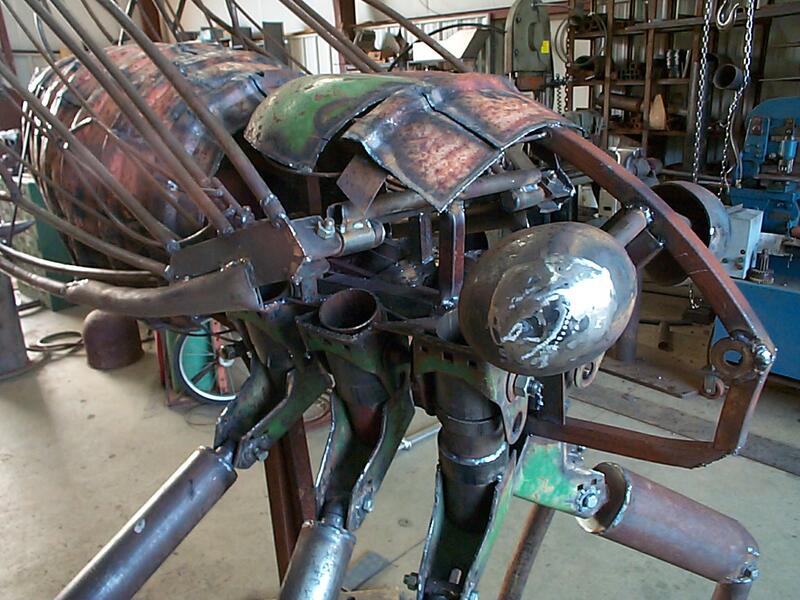 Face in progress
Face in progress -
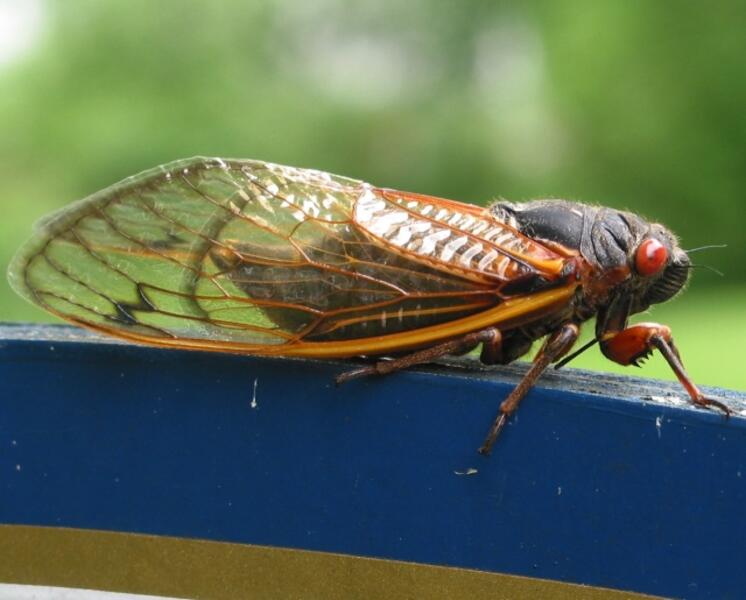 The model
The model
Cateraptasaurus
The Cateraptasaurus was created for "Sculpture at Evergreen", an outdoor sculpture exhibition at The Evergreen House in Baltimore, Maryland. It was also made possible by the late Alban Tractor Company who proudly displayed the creature at their Pulaski Highway facility.
The Cateratasaurus weighs in at over 13,000 pounds, and stands 13 feet 4 inches high!
The Cateratasaurus weighs in at over 13,000 pounds, and stands 13 feet 4 inches high!
-
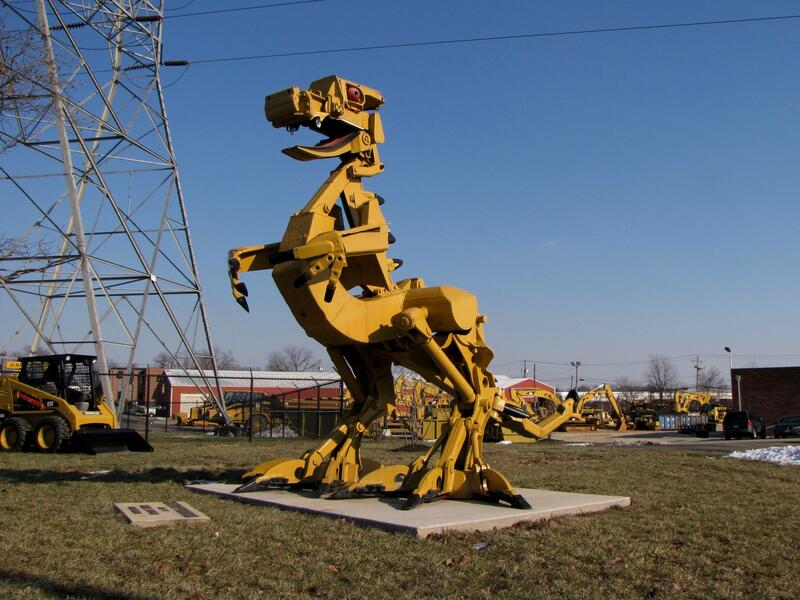 Cateraptasaurus on Pulaski HighwayCateraptasaurus, located at the late Alban Tractor Company, Rosedale, Maryland. It's thirteen and a half feet high and 12,500 lbs.
Cateraptasaurus on Pulaski HighwayCateraptasaurus, located at the late Alban Tractor Company, Rosedale, Maryland. It's thirteen and a half feet high and 12,500 lbs. -
 1946 Caterpillar ScraperThis is the machine that provided many of the components used.
1946 Caterpillar ScraperThis is the machine that provided many of the components used. -
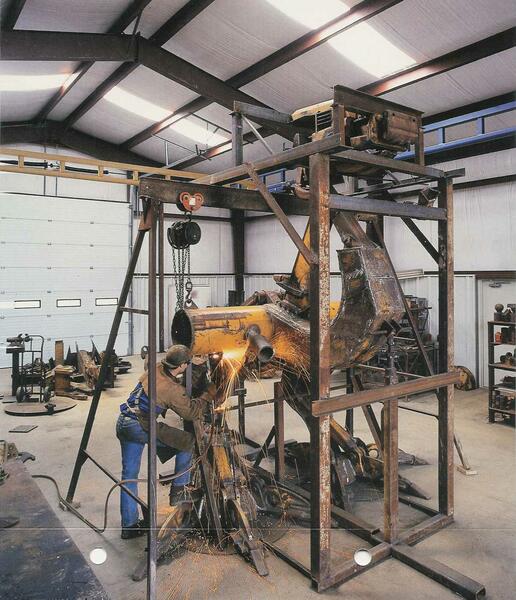 CateraptasaurusDuring construction
CateraptasaurusDuring construction -
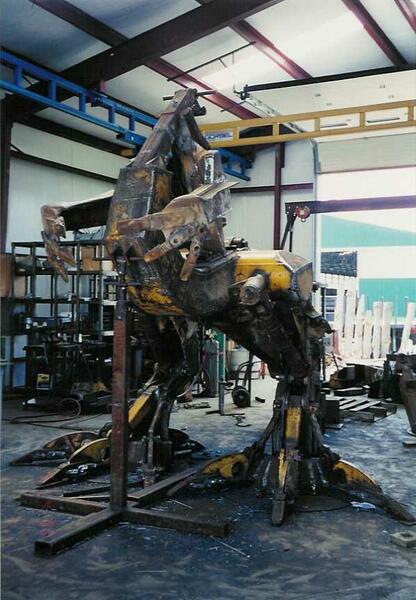 Disassembling to move
Disassembling to move -
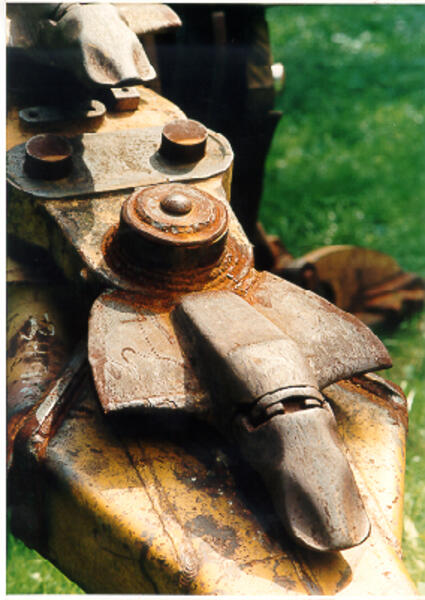 Hinge detail at tail joint
Hinge detail at tail joint -
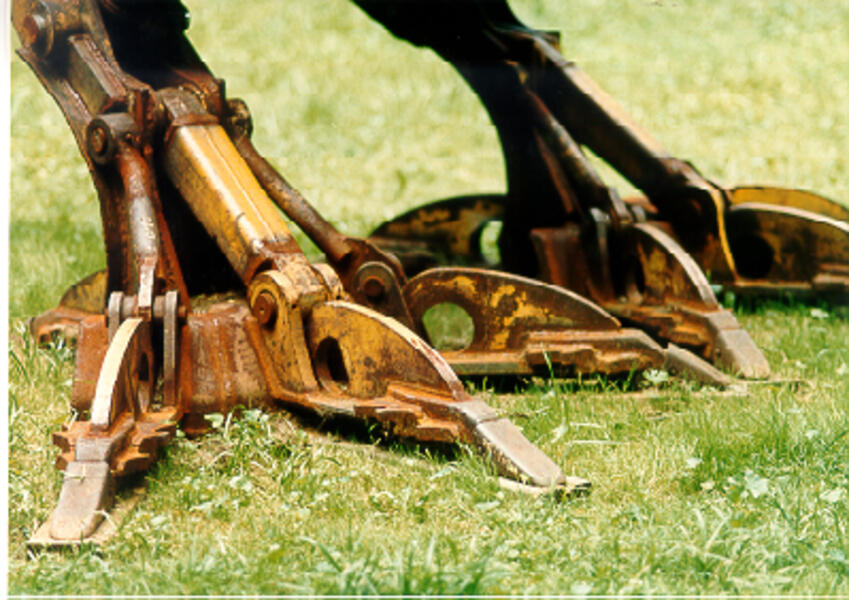 The Feet
The Feet -
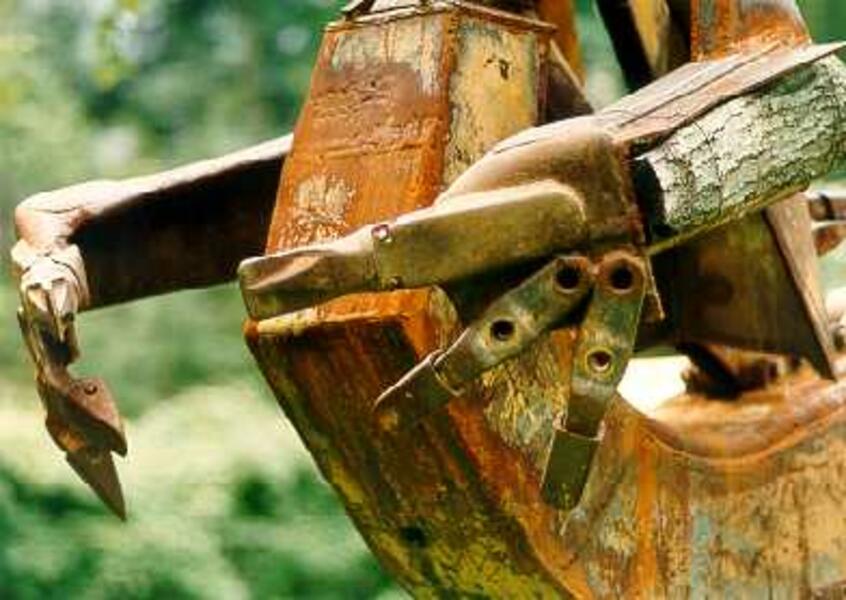 Bucket tooth fingers
Bucket tooth fingers -
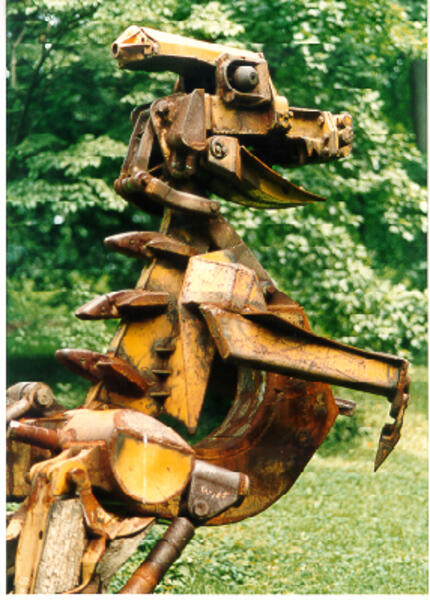 Spikes on the backThe spikes on the back weigh about a hundred pounds each and were teeth from a quarry loader bucket.
Spikes on the backThe spikes on the back weigh about a hundred pounds each and were teeth from a quarry loader bucket. -
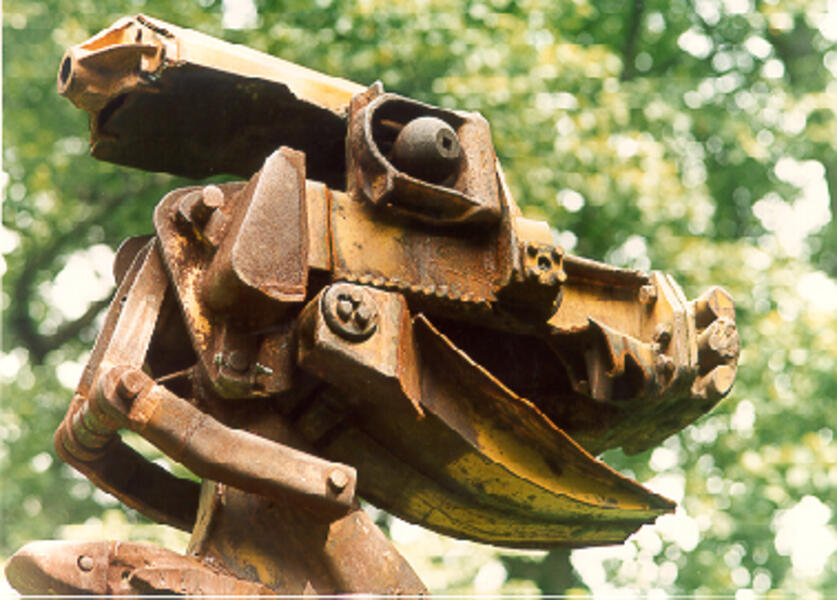 The HeadThe head weighs 1100 lbs.
The HeadThe head weighs 1100 lbs. -
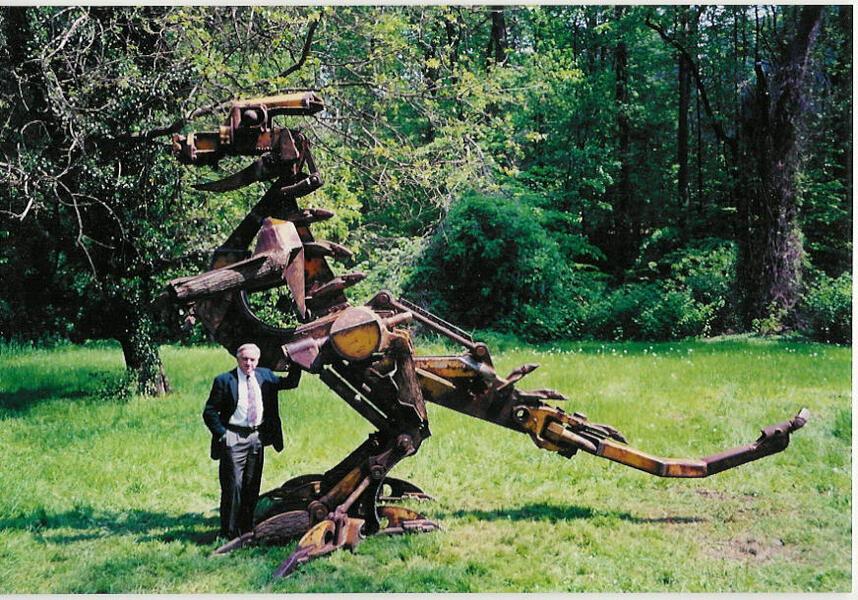 Cateraptasaurus at Evergreen
Cateraptasaurus at Evergreen
Vehicles
"From Bedrock to Bartertown" is built on the chassis of a 1972 V.W. Beetle. I built it in 1995 with the help of Baltimore's Festival of the Arts: Artscape.
The materials that make up the body are chunks of oak, sycamore, maple, cherry and other wood. These materials are combined with disc plow and combine parts, pieces of a chimney flue and various other scrap metal. It has safety glass and improved suspension. The back end opens up to get access to the motor.
The car is natural and organic, a mix of the past and the future. In the car's name, Bedrock refers to the past and is influenced by the Flintstones. Bartertown is inspired by the Mad Max movies.
The pedal car was made as a human powered vehicle also made possible by Baltimore's Artscape. I constructed it in 1997. It weighed in at about 700 pounds and was powered by a person, pedaling a flywheel. In turn it used the inertia from the spinning weight to engage the drive wheels. It worked pretty well as long as you weren't going up hill..
The last vehicle was my 1987 Ford Ranger. Again a project for Baltimore's Artscape, 2009. I removed everything that was not essential for vehicle to run, including all the sheet metal and all the structure above the frame. I then used an 1960's Horn/ New Idea front end loader from a tractor and some pipes that I salvaged from the American Brewery. I moved the seat to the bed of the truck and also put the steering wheel in the middle. It has a summer dogsled cart for a front grill and some caterpillar tractor parts too. It became a super dangerous field runner that was loads of fun to drive.
The materials that make up the body are chunks of oak, sycamore, maple, cherry and other wood. These materials are combined with disc plow and combine parts, pieces of a chimney flue and various other scrap metal. It has safety glass and improved suspension. The back end opens up to get access to the motor.
The car is natural and organic, a mix of the past and the future. In the car's name, Bedrock refers to the past and is influenced by the Flintstones. Bartertown is inspired by the Mad Max movies.
The pedal car was made as a human powered vehicle also made possible by Baltimore's Artscape. I constructed it in 1997. It weighed in at about 700 pounds and was powered by a person, pedaling a flywheel. In turn it used the inertia from the spinning weight to engage the drive wheels. It worked pretty well as long as you weren't going up hill..
The last vehicle was my 1987 Ford Ranger. Again a project for Baltimore's Artscape, 2009. I removed everything that was not essential for vehicle to run, including all the sheet metal and all the structure above the frame. I then used an 1960's Horn/ New Idea front end loader from a tractor and some pipes that I salvaged from the American Brewery. I moved the seat to the bed of the truck and also put the steering wheel in the middle. It has a summer dogsled cart for a front grill and some caterpillar tractor parts too. It became a super dangerous field runner that was loads of fun to drive.
-
 From Bedrock to BartertownA Volkswagen chassis under a body made of trees and farm equipment.
From Bedrock to BartertownA Volkswagen chassis under a body made of trees and farm equipment. -
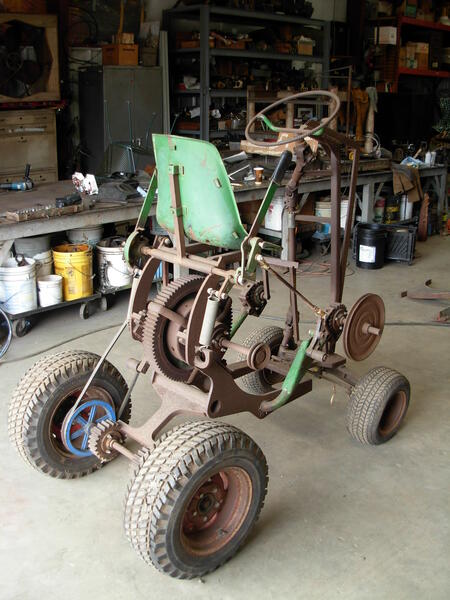 Pedal CarThis vehicle is human powered. The operator pedals a flywheel and transfers its inertia to the drive wheels by way of clutches.
Pedal CarThis vehicle is human powered. The operator pedals a flywheel and transfers its inertia to the drive wheels by way of clutches. -
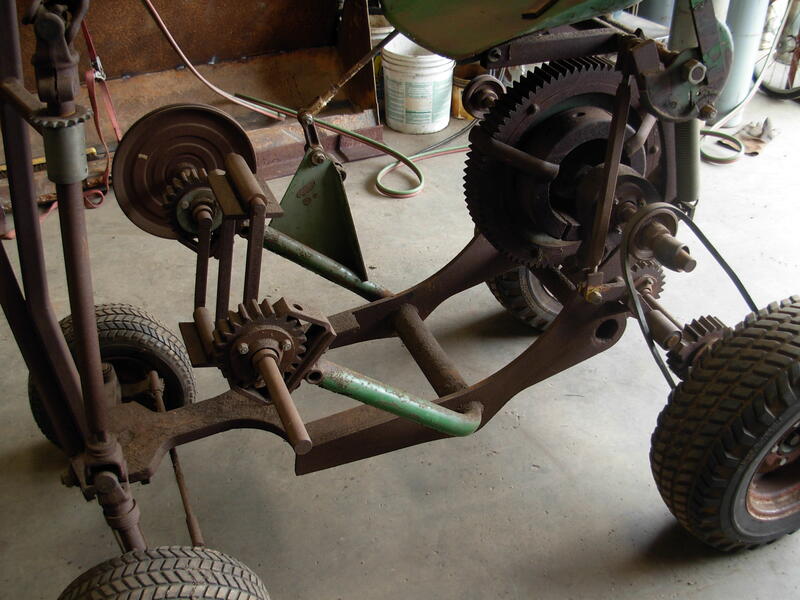 Pedal Car
Pedal Car -
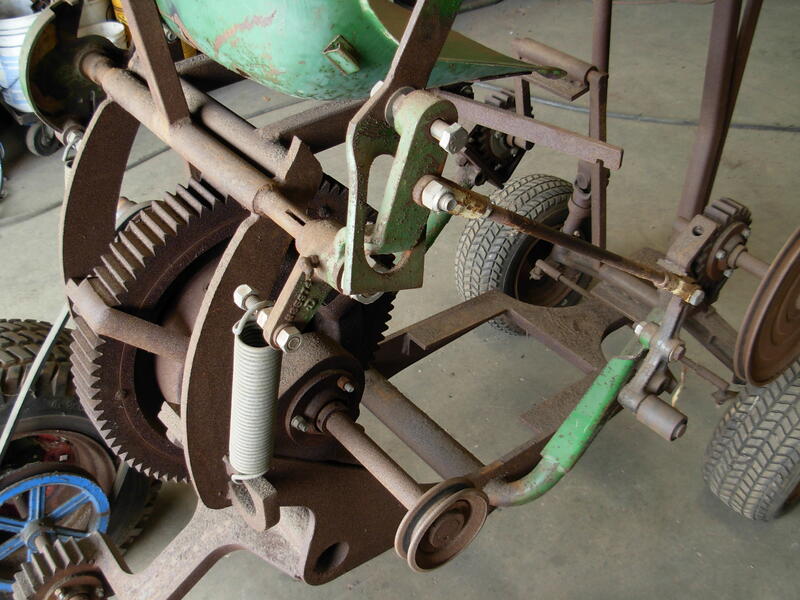 Pedal Car
Pedal Car -
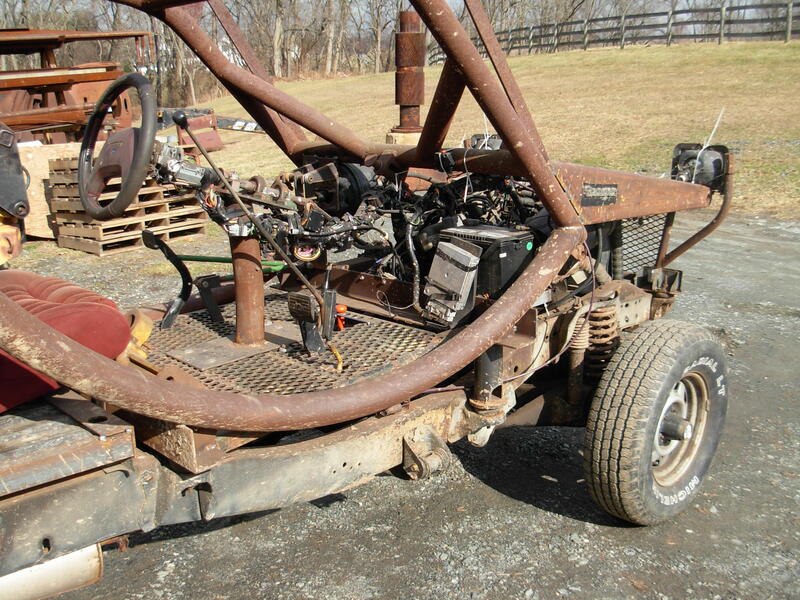 87 Ford RangerI had to keep the computer and most of the electrical components.
87 Ford RangerI had to keep the computer and most of the electrical components. -
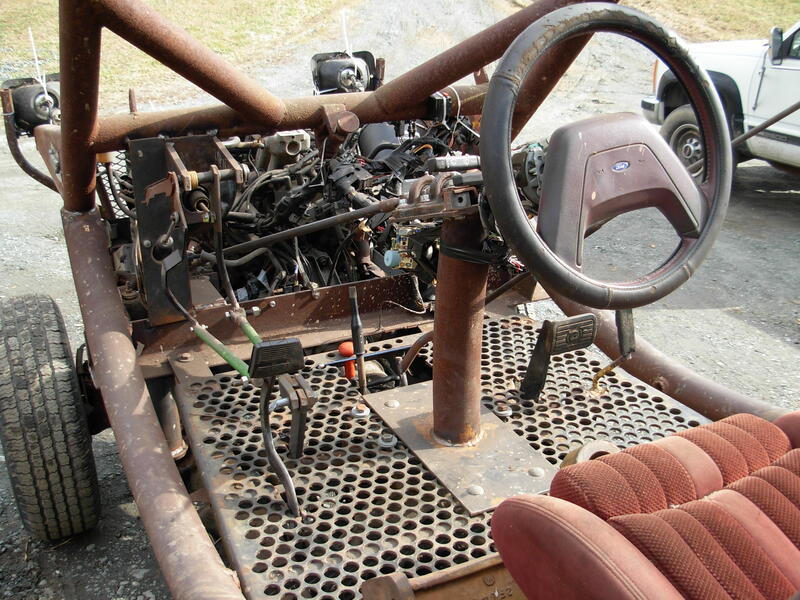 87 Ford RangerI moved the seat and steering wheel into the middle. Rebuilt just about everything.
87 Ford RangerI moved the seat and steering wheel into the middle. Rebuilt just about everything. -
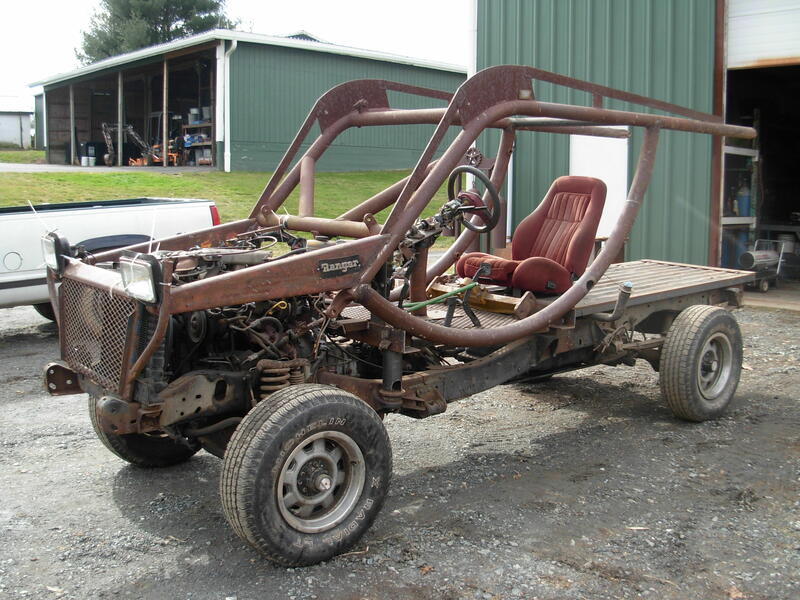 87 Ford RangerRefashioned for Baltimore's Artscape. I wanted to remove everything that wasn't necessary for the vehicle to run, and I wanted to sit in the middle.
87 Ford RangerRefashioned for Baltimore's Artscape. I wanted to remove everything that wasn't necessary for the vehicle to run, and I wanted to sit in the middle.
Various Works
Various works.
-
 HogfishThis piece weighs about 500 pounds and is located in front of the Hogfish Bar and Grill in Stock Island, Florida.
HogfishThis piece weighs about 500 pounds and is located in front of the Hogfish Bar and Grill in Stock Island, Florida. -
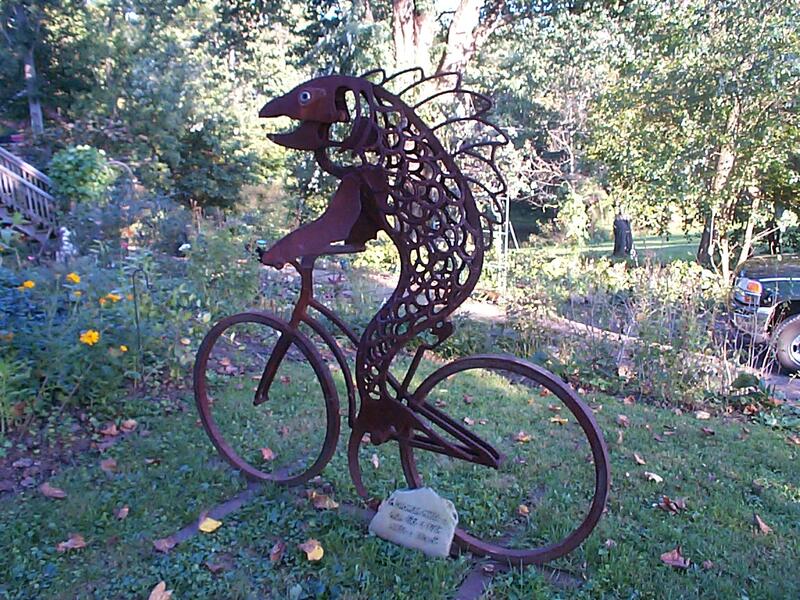 Fish on a BikeMade from steel plate and horseshoes.
Fish on a BikeMade from steel plate and horseshoes. -
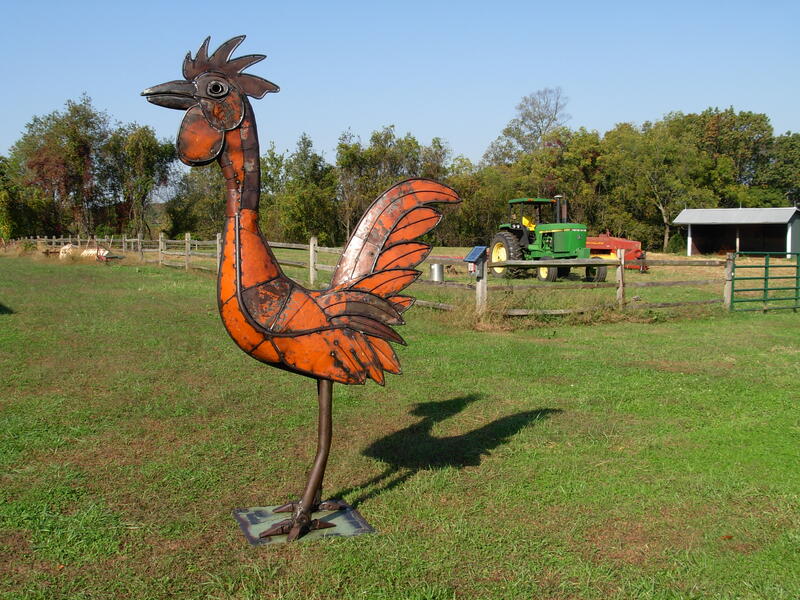 Red RoosterThis fellow started with a few curved pipes that I had laying around. I skinned it with sheet metal from a 1960's Allis Chalmers corn chopper.
Red RoosterThis fellow started with a few curved pipes that I had laying around. I skinned it with sheet metal from a 1960's Allis Chalmers corn chopper. -
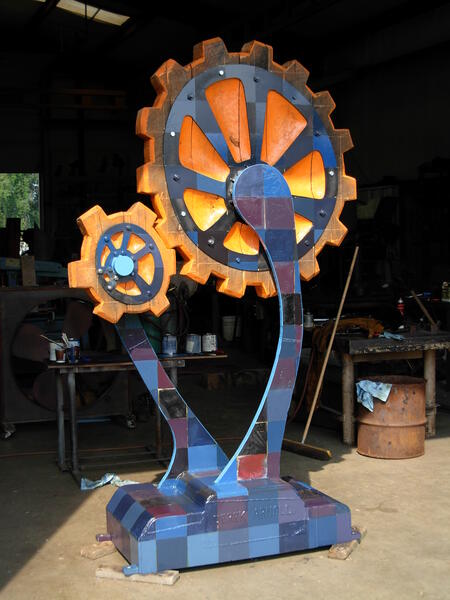 Cartoon GearsThis piece is about 8 feet tall an is made of locust wood and steel.
Cartoon GearsThis piece is about 8 feet tall an is made of locust wood and steel. -
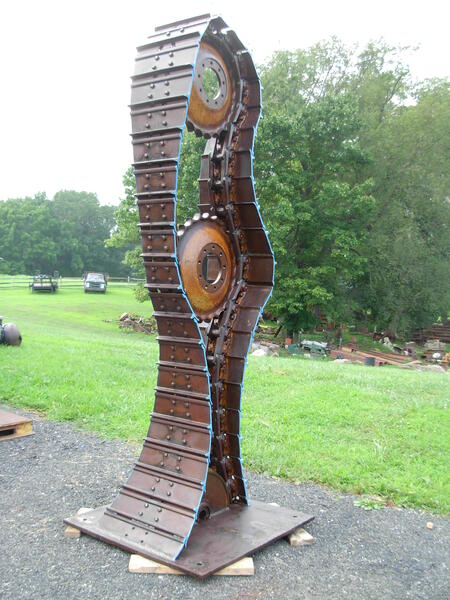 Dozer TracksI welded the links together and cut the track pads to make this form. It weighs about a ton.
Dozer TracksI welded the links together and cut the track pads to make this form. It weighs about a ton. -
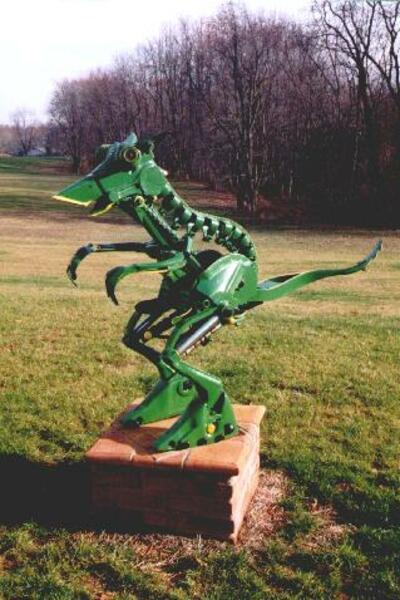 VerdantisaurusThis piece is made mostly from John Deere tractor parts. It is about four feet tall.
VerdantisaurusThis piece is made mostly from John Deere tractor parts. It is about four feet tall. -
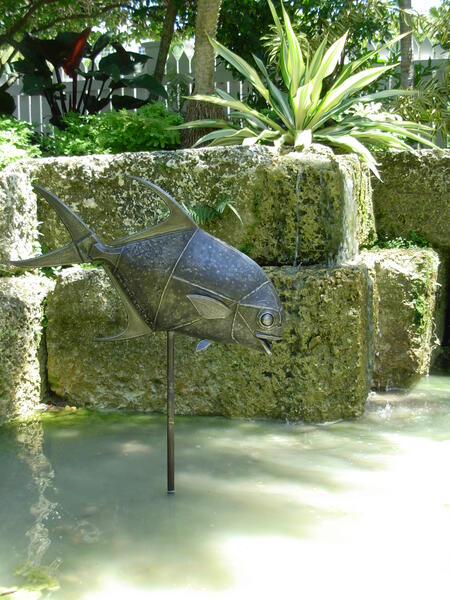 Permit FishThis steel Permit fish is part of a garden water feature. The pool is tidal and constantly changes depths . It is about two and a half feet, nose to tail.
Permit FishThis steel Permit fish is part of a garden water feature. The pool is tidal and constantly changes depths . It is about two and a half feet, nose to tail. -
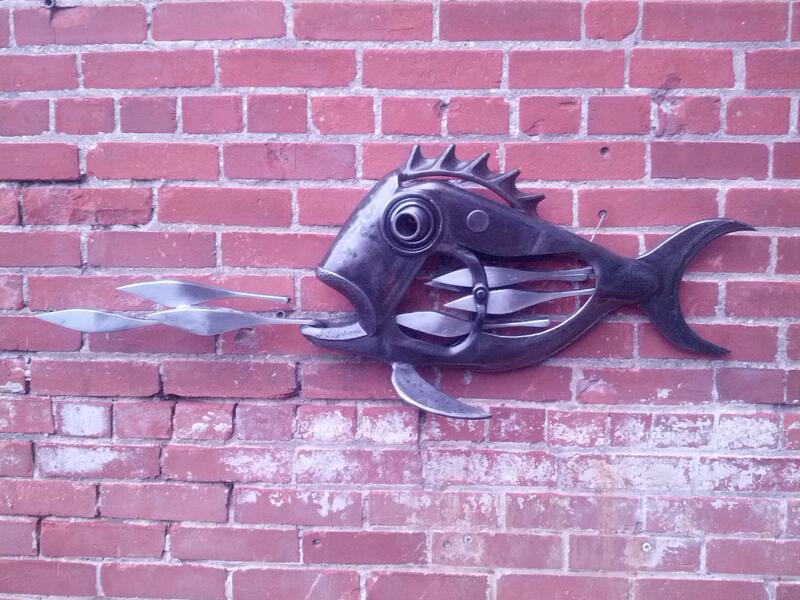 Wall hanging Belly FishThe sculpture has a belly full and is still hungry.
Wall hanging Belly FishThe sculpture has a belly full and is still hungry. -
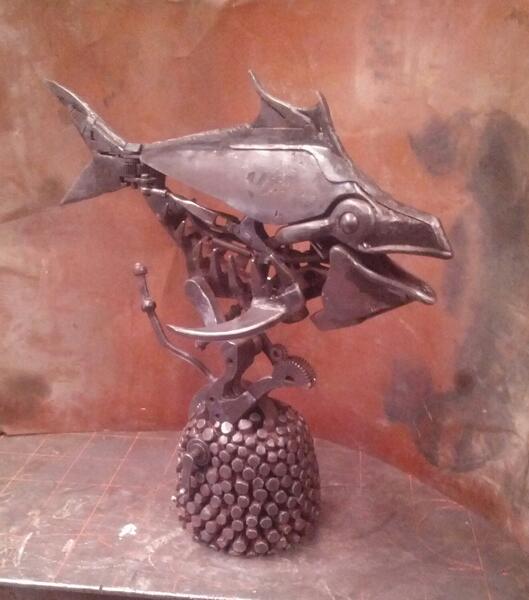 Hand operated fishThis sculpture moves by turning a handle. It then turns a flywheel which actuates linkage and levers that open and close the mouth also moving the tail back and forth.
Hand operated fishThis sculpture moves by turning a handle. It then turns a flywheel which actuates linkage and levers that open and close the mouth also moving the tail back and forth. -
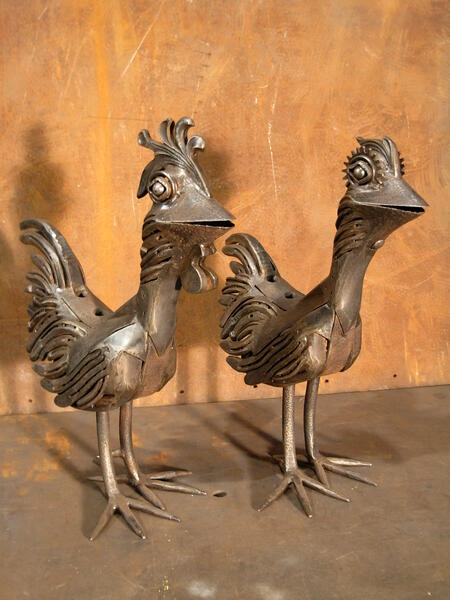 Rooster and HenThis pair is about 18 inches high. They are mostly forged into shape and contain a few parts such as horseshoes and cultivator parts.
Rooster and HenThis pair is about 18 inches high. They are mostly forged into shape and contain a few parts such as horseshoes and cultivator parts.
Serpent
In 1993, soon after graduating from Maryland Institue College of Art, I packed this sculpture into my truck and headed to Lenexa, Kansas for a weekend "Art in the Park". When I arrived, they had picked a location for the artwork on an island in the middle of a large pond. There were walkways leading around the park and many permanent sculpture installations. The city arts council purchased my sculpture and it is still on location. The sculpture was originally a combination of wood and steel. After 16 years the wood had mostly rotted away, so I decided to rebuild the piece. In 2009 I went back to Kansas and spent about a week rebuilding the piece with all steel parts.
-
 Serpent1993 Installed in Sar Co Par Park, Lenexa Kansas after city Purchase Award
Serpent1993 Installed in Sar Co Par Park, Lenexa Kansas after city Purchase Award -
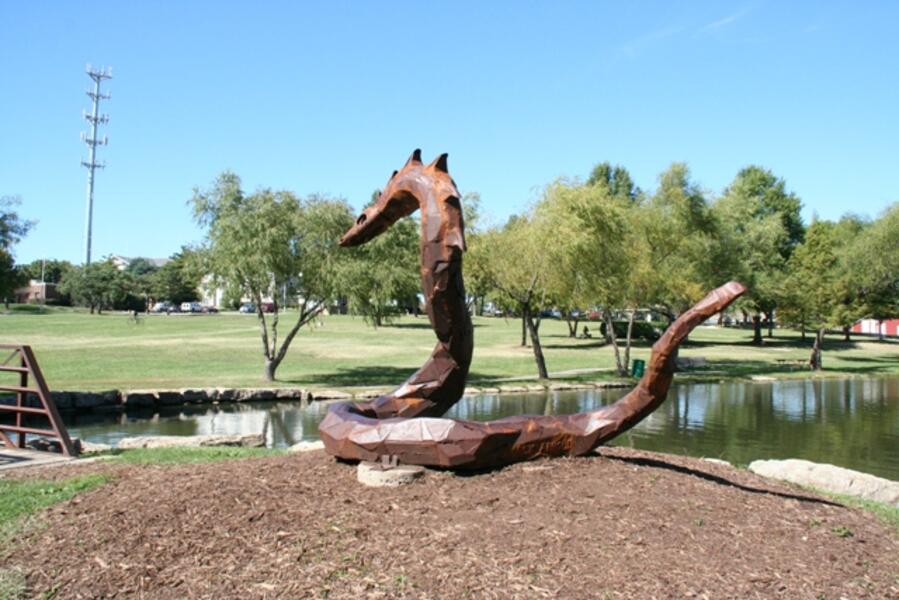 No more woodOutfitted with new steel spines.
No more woodOutfitted with new steel spines. -
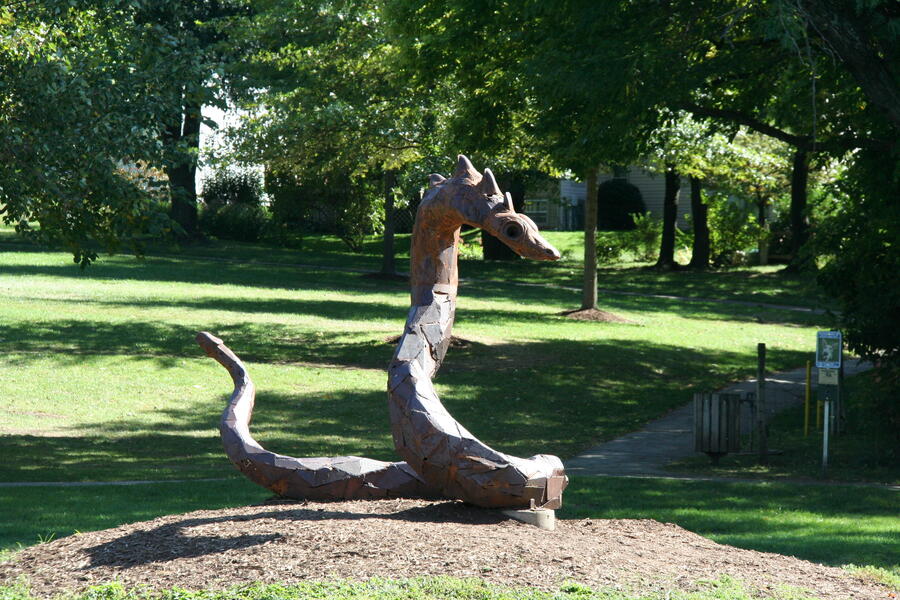 Late afternoon
Late afternoon -
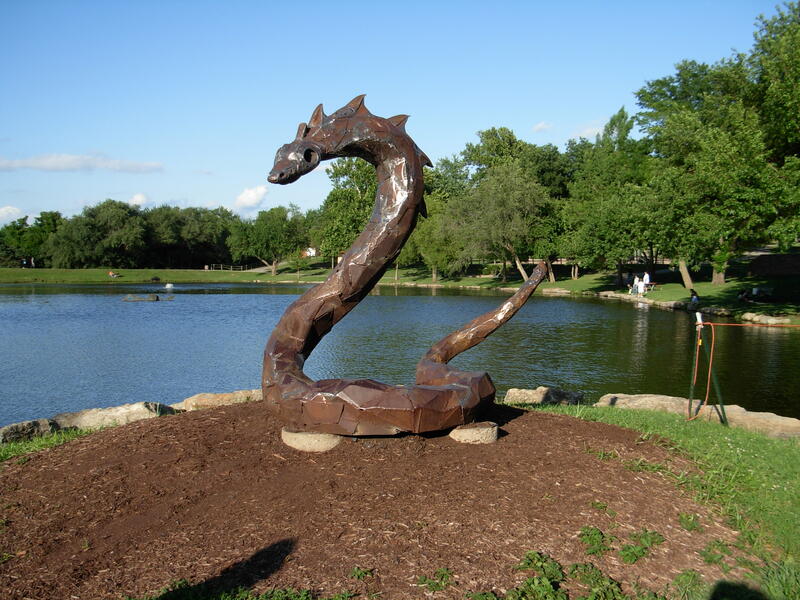 Serpent of LenexaThis 800 pound creature sits on an island in a large park in Lenexa, Kansas.
Serpent of LenexaThis 800 pound creature sits on an island in a large park in Lenexa, Kansas. -
 Head detail
Head detail -
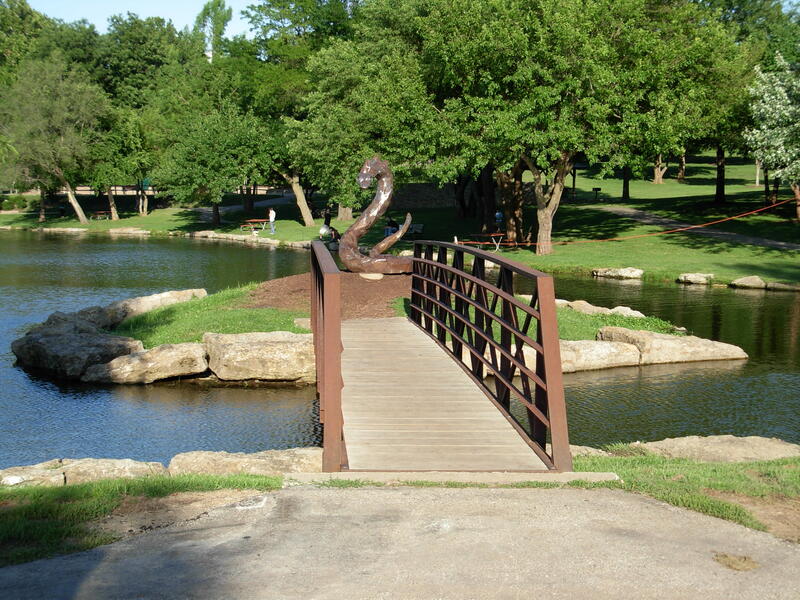 Across the bridge
Across the bridge -
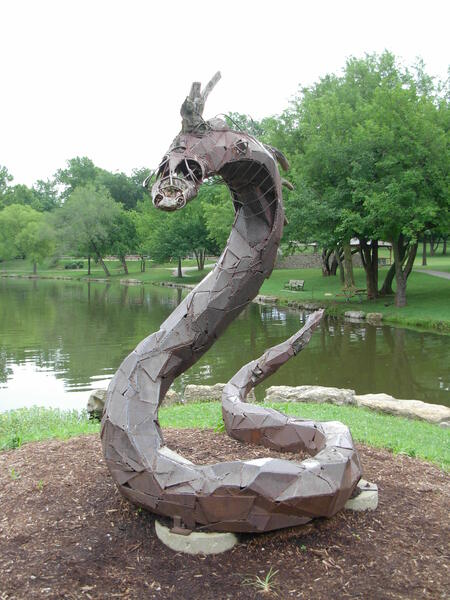 2009 In need of repairThe original wood pieces had rotted away after sixteen years.
2009 In need of repairThe original wood pieces had rotted away after sixteen years. -
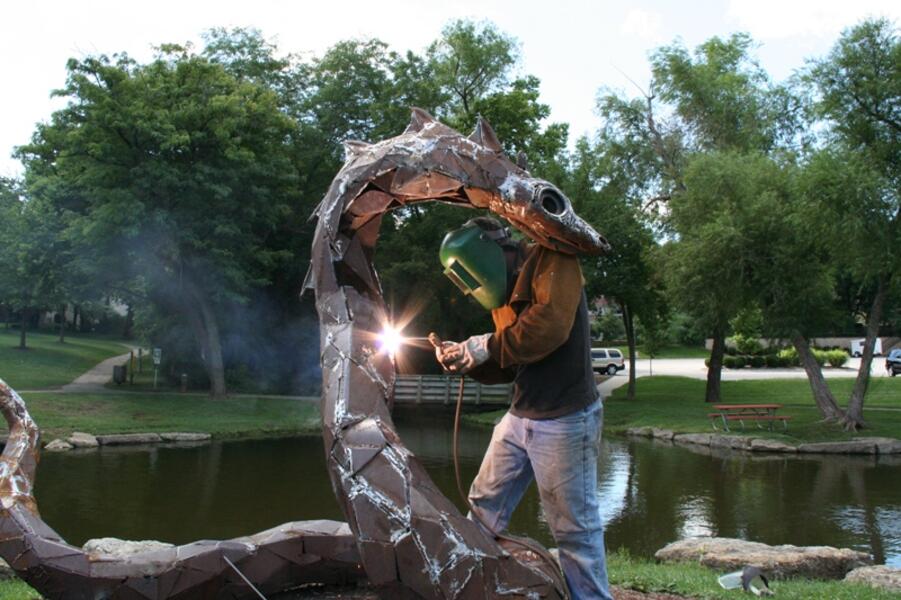 Welding the steel plates
Welding the steel plates
Chocolate Moose
The Chocolate Moose is made for Jemicy School. Originally, one of the founders of the school had built a moose from logs and used steel rebar to create antlers. After time disolved several versions of the log moose and many years later, I was asked to construct a new moose. I was to interpret the old moose, and create a new, more permanent moose.
My idea was to build a steel moose that would appear quite simple but combine visual and mechanical complexities. The surface relief depicts some of the real placement of the bones found in the shoulders and hips of a moose. Mechanical obects such as tractor parts and crane truck parts are included to create a stylistic idea of moose anatomy. The thin body is reminiscent of the simple logs.
My idea was to build a steel moose that would appear quite simple but combine visual and mechanical complexities. The surface relief depicts some of the real placement of the bones found in the shoulders and hips of a moose. Mechanical obects such as tractor parts and crane truck parts are included to create a stylistic idea of moose anatomy. The thin body is reminiscent of the simple logs.
